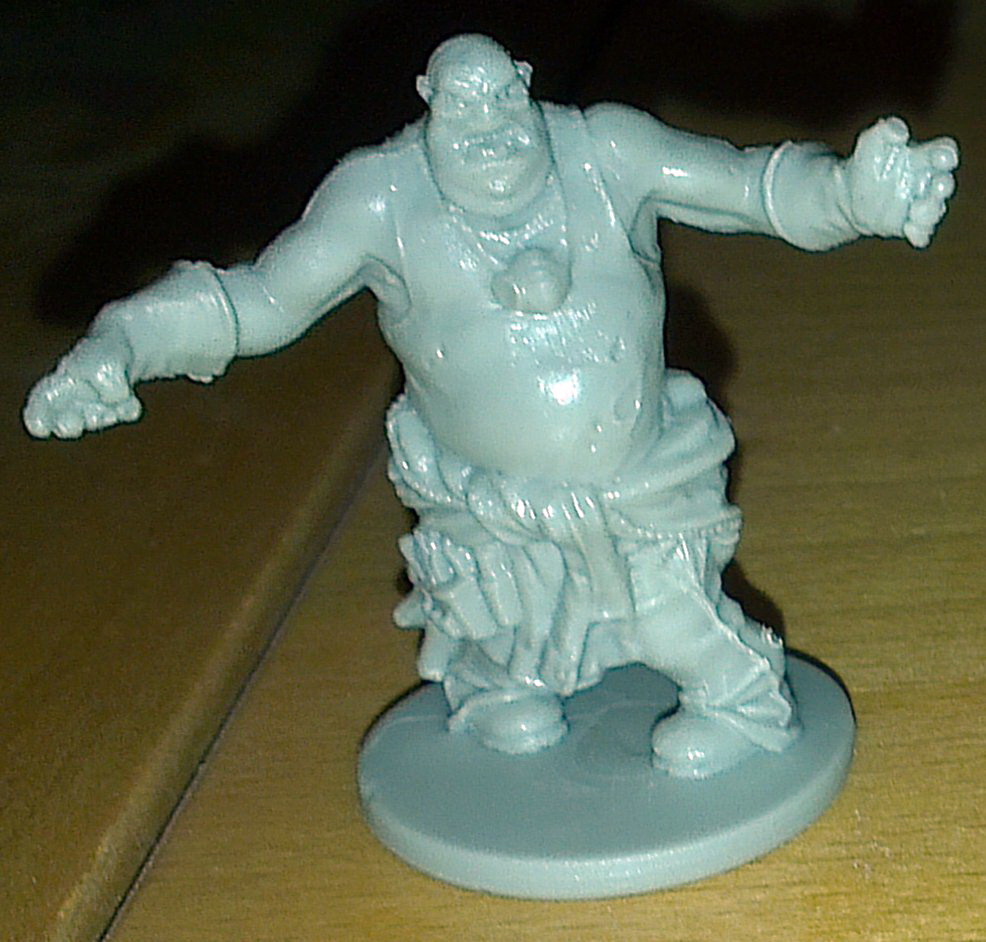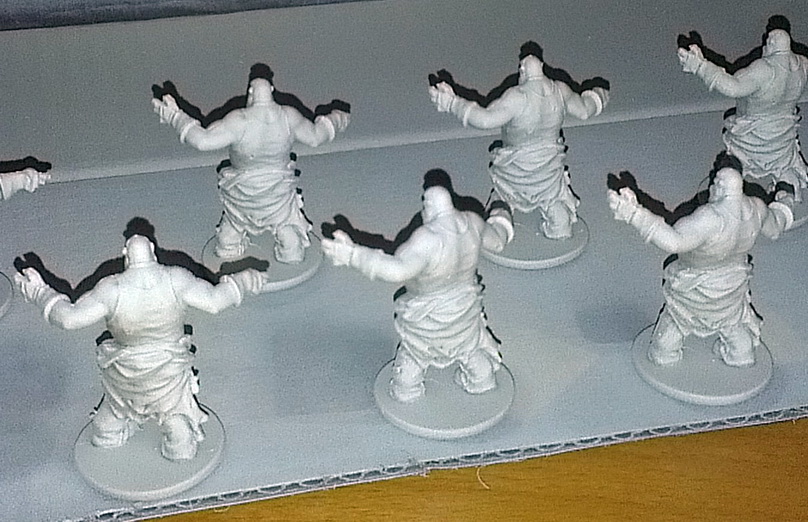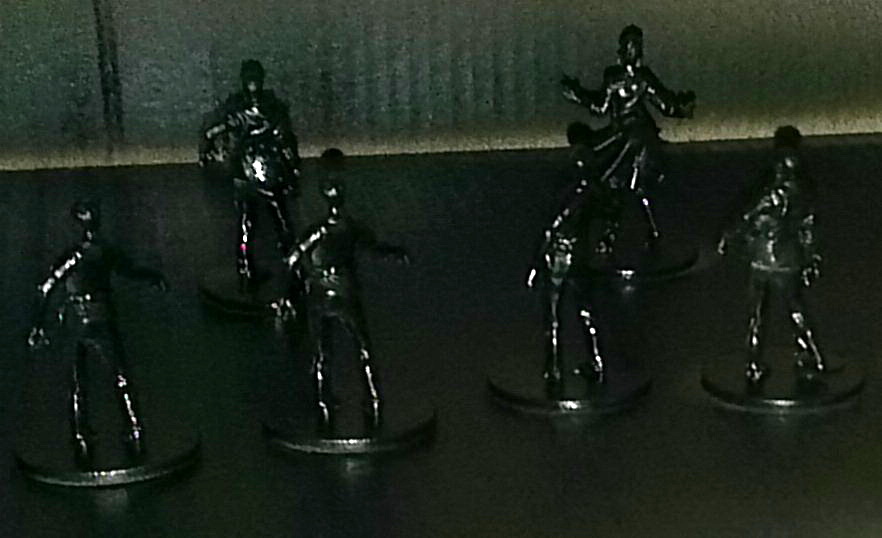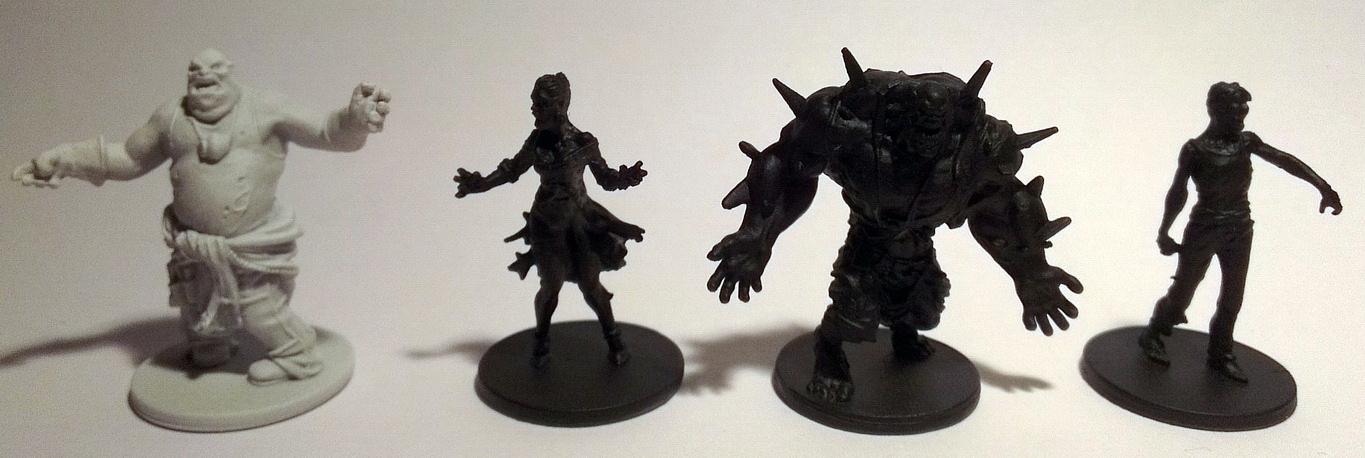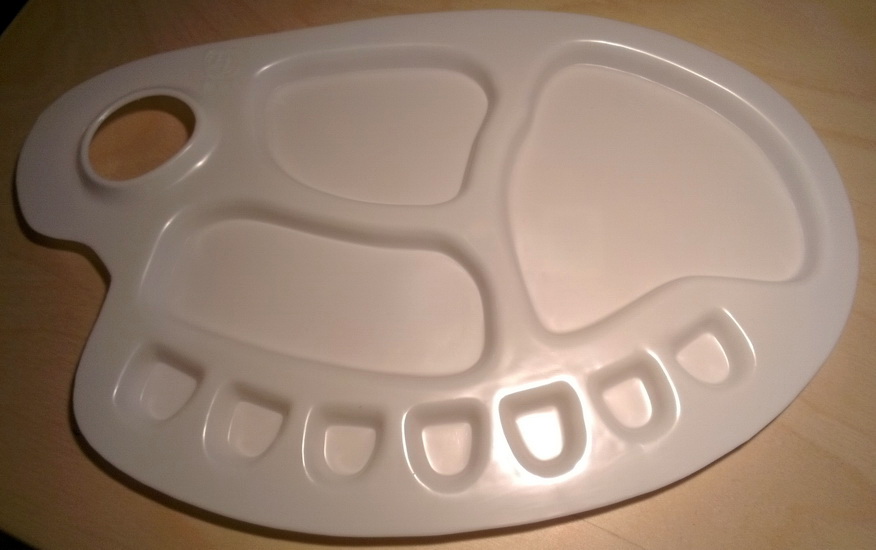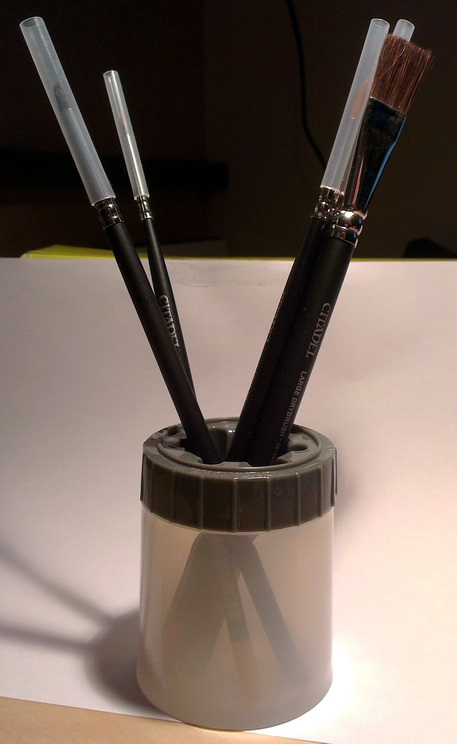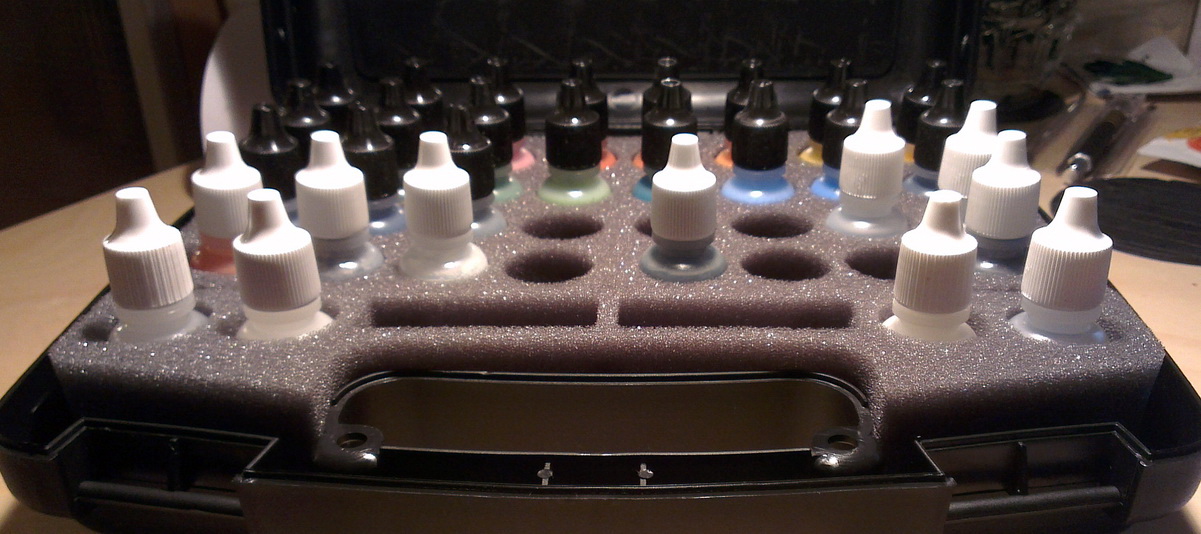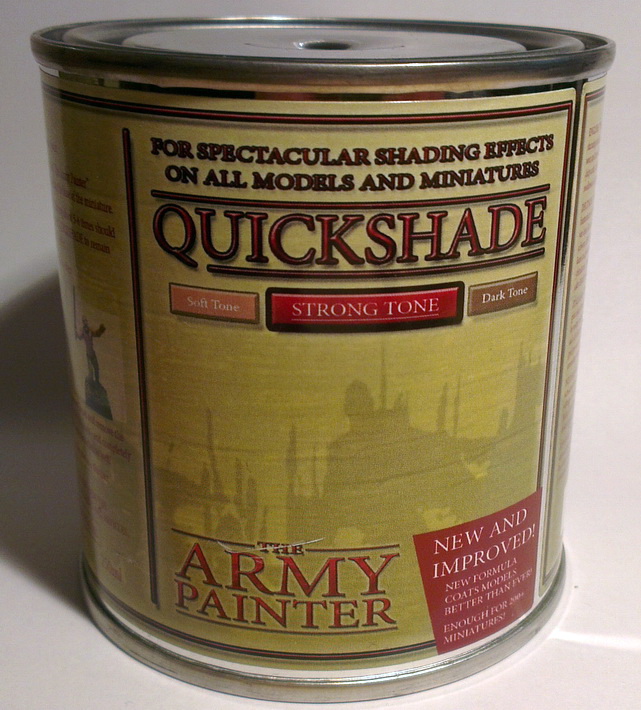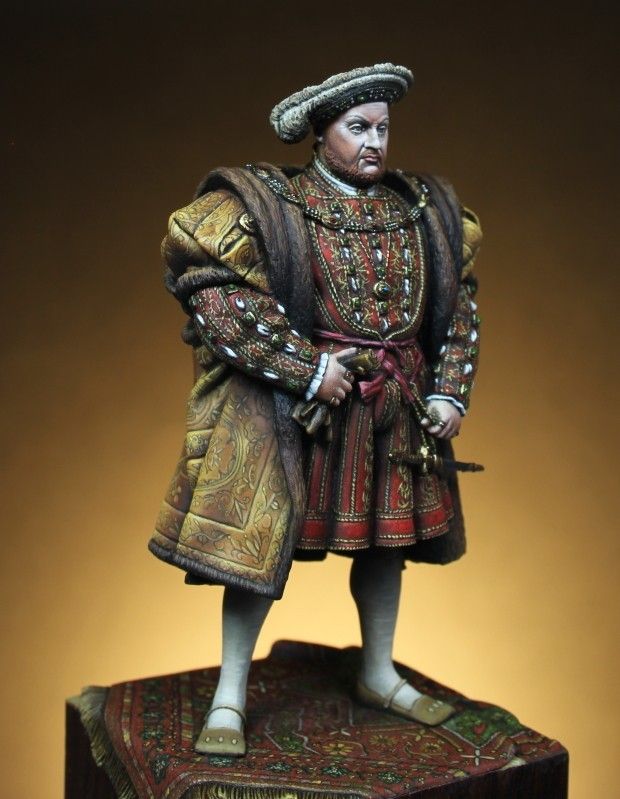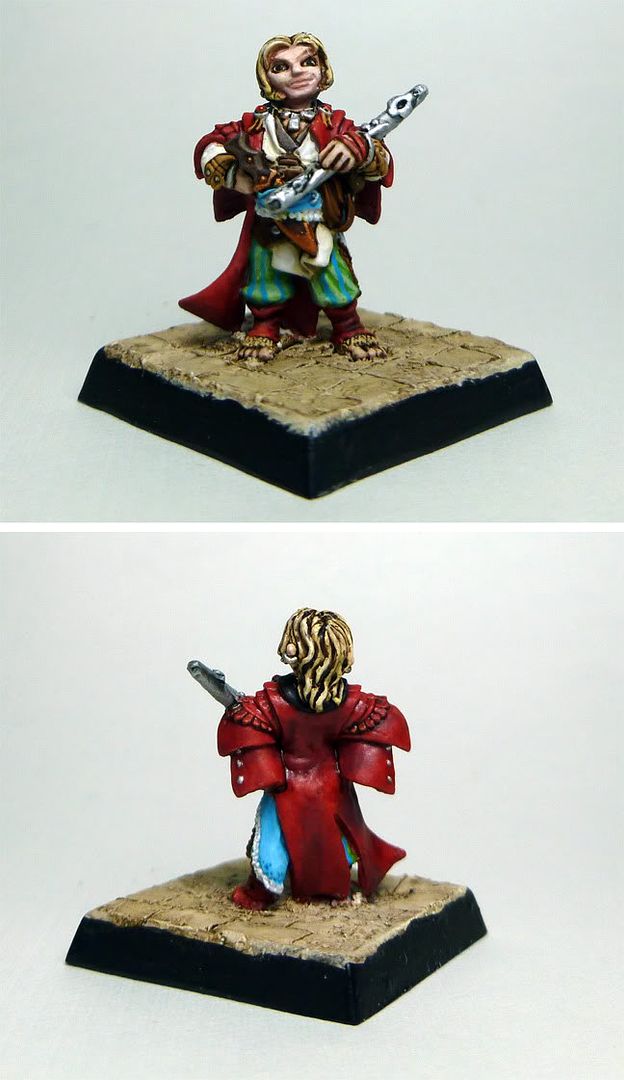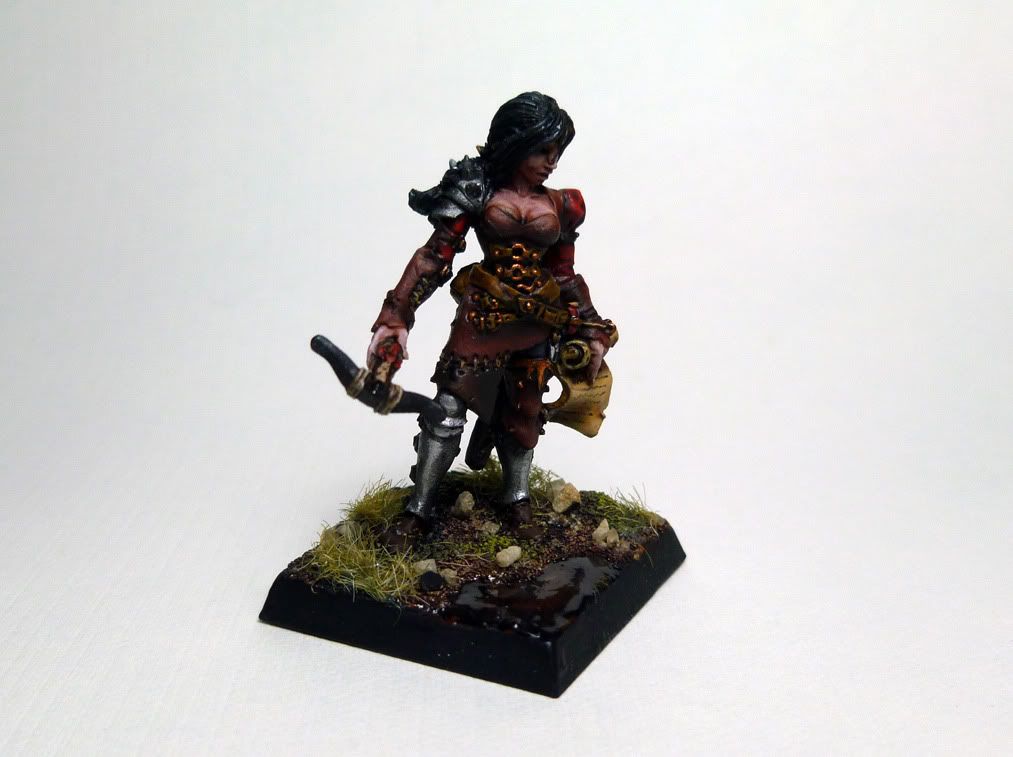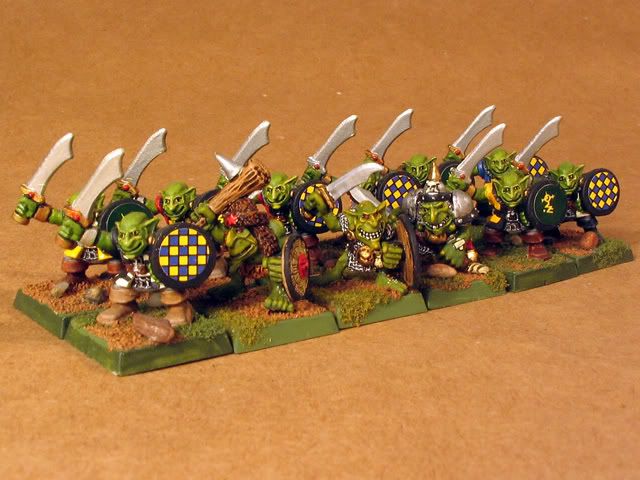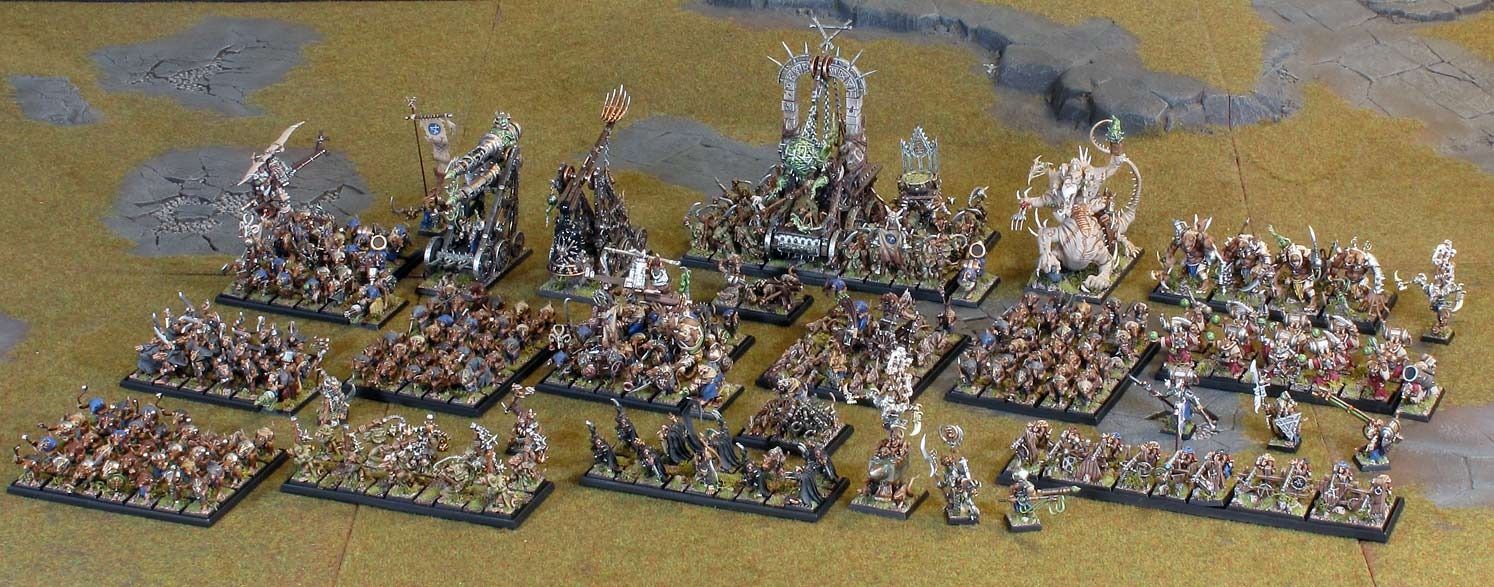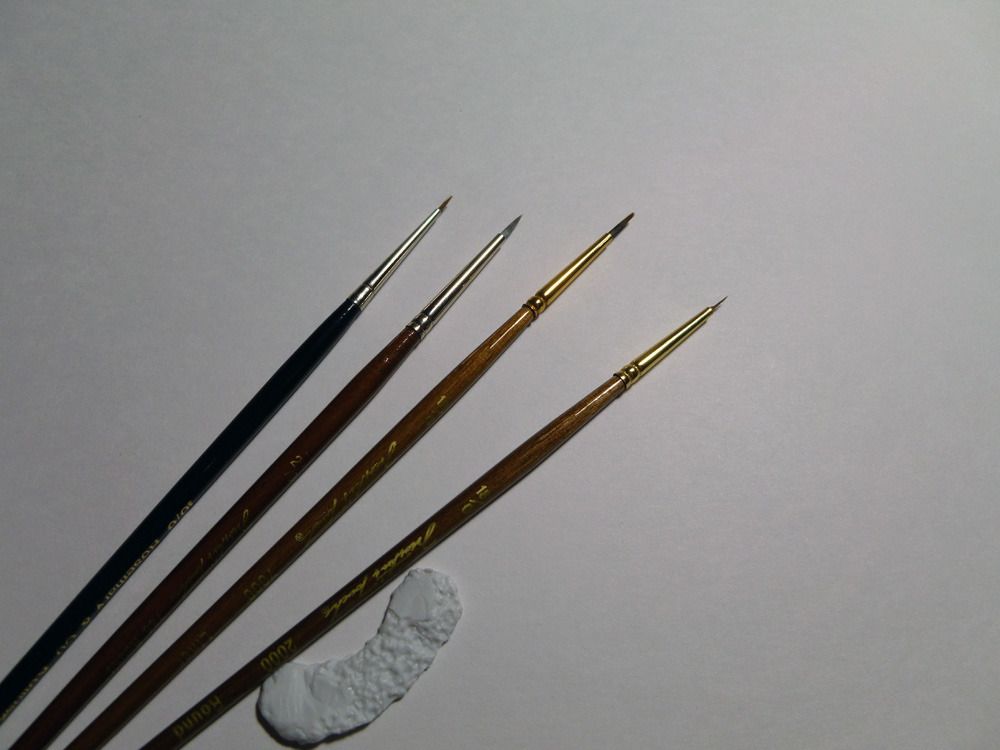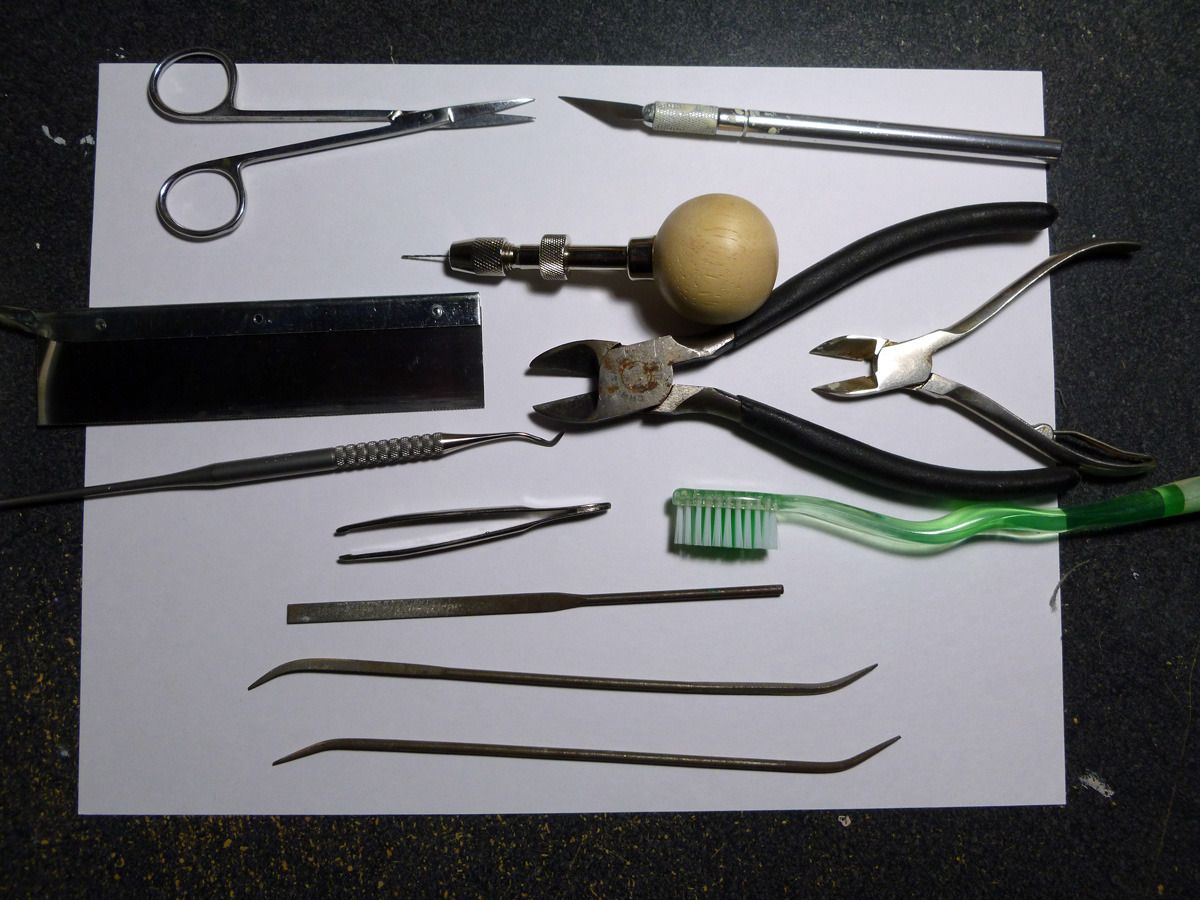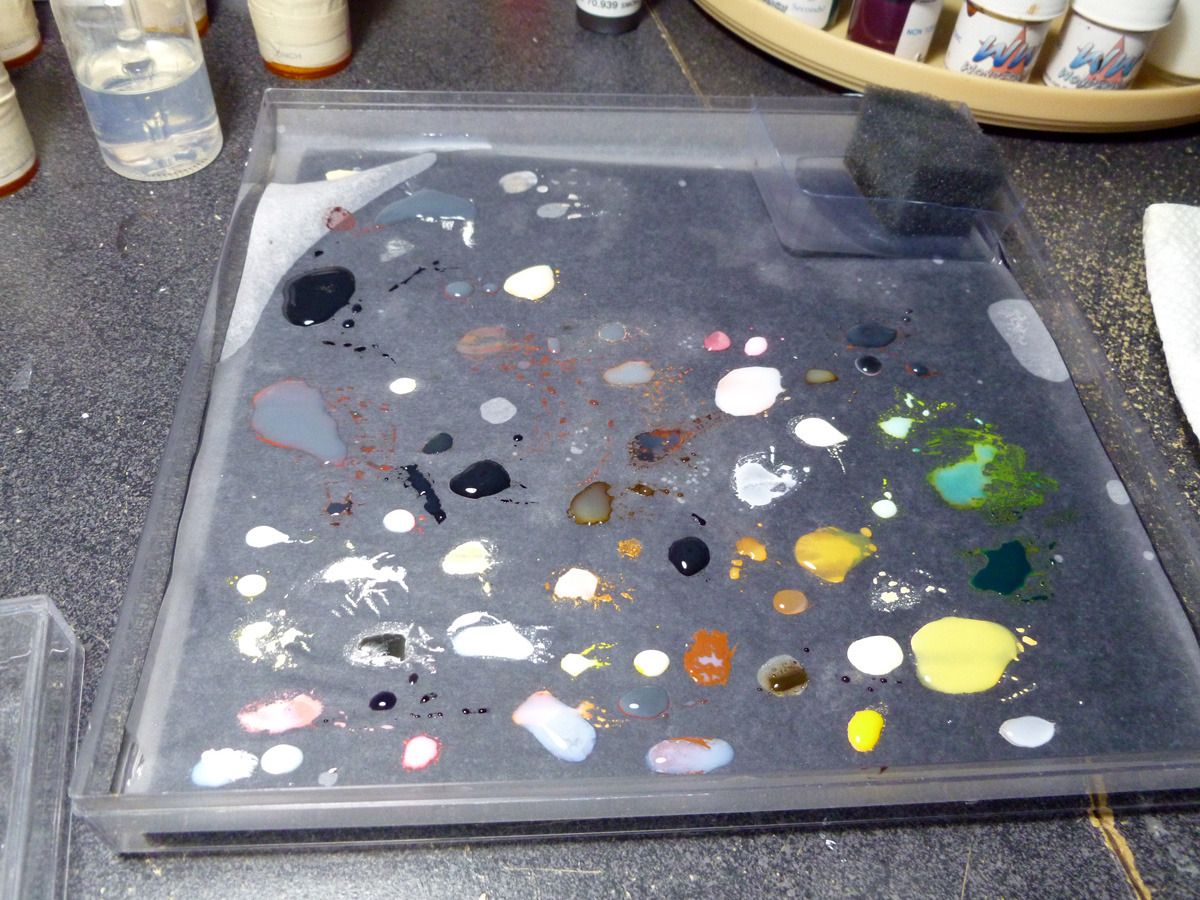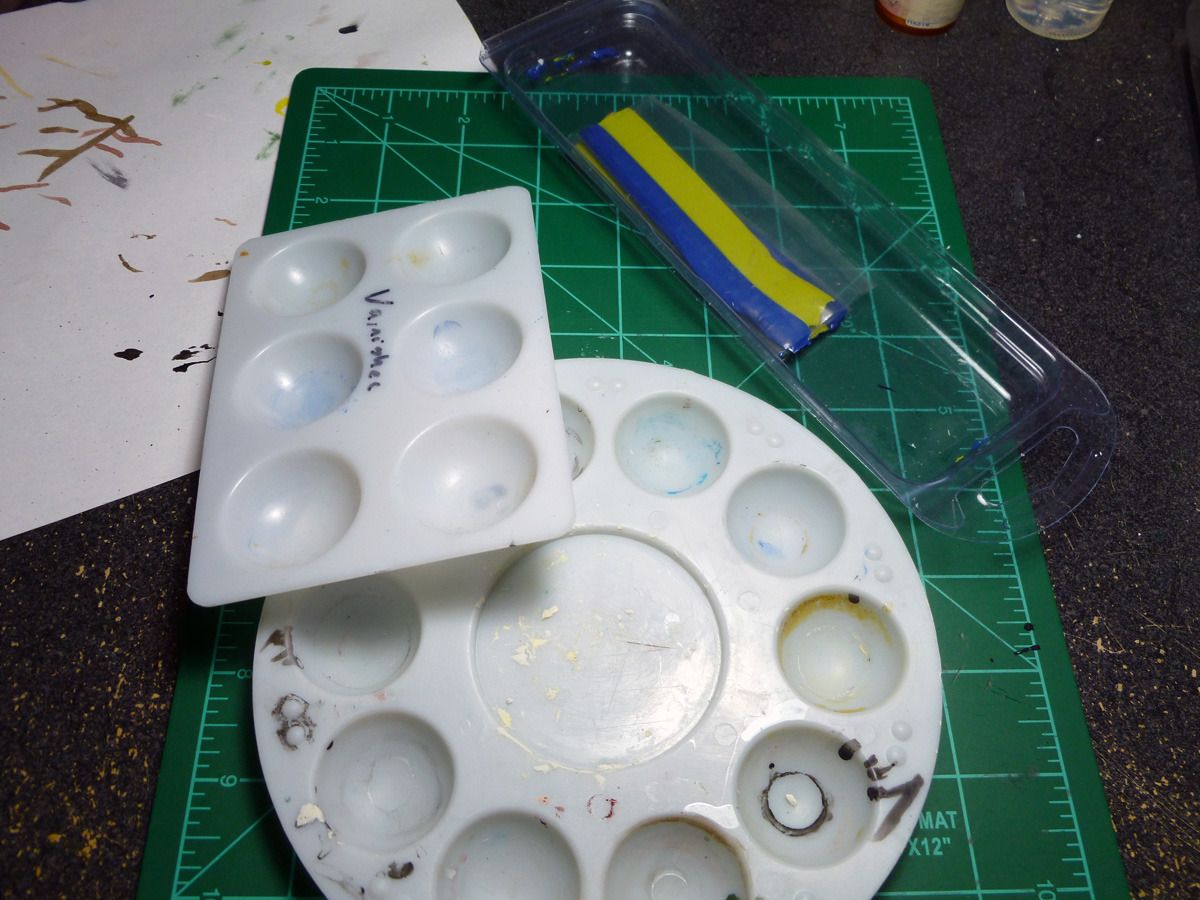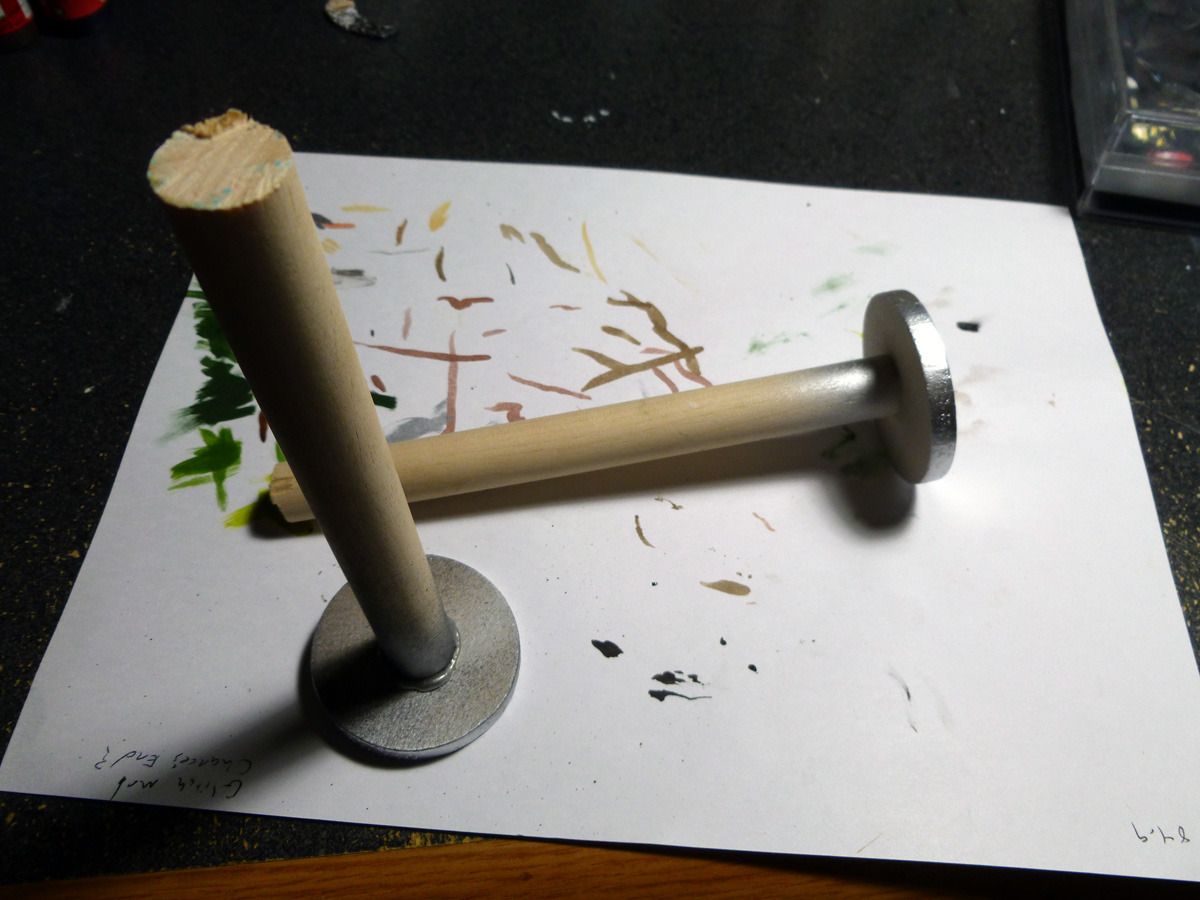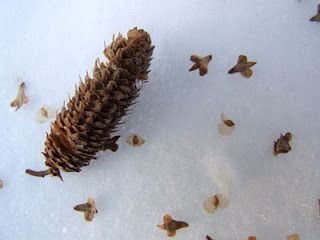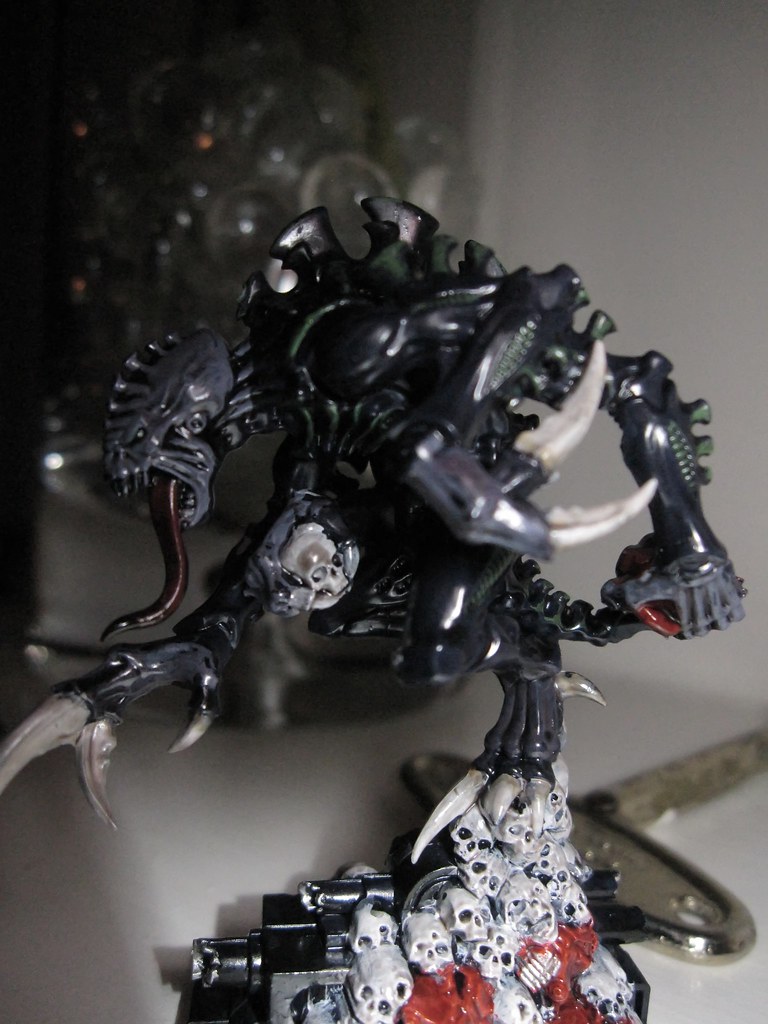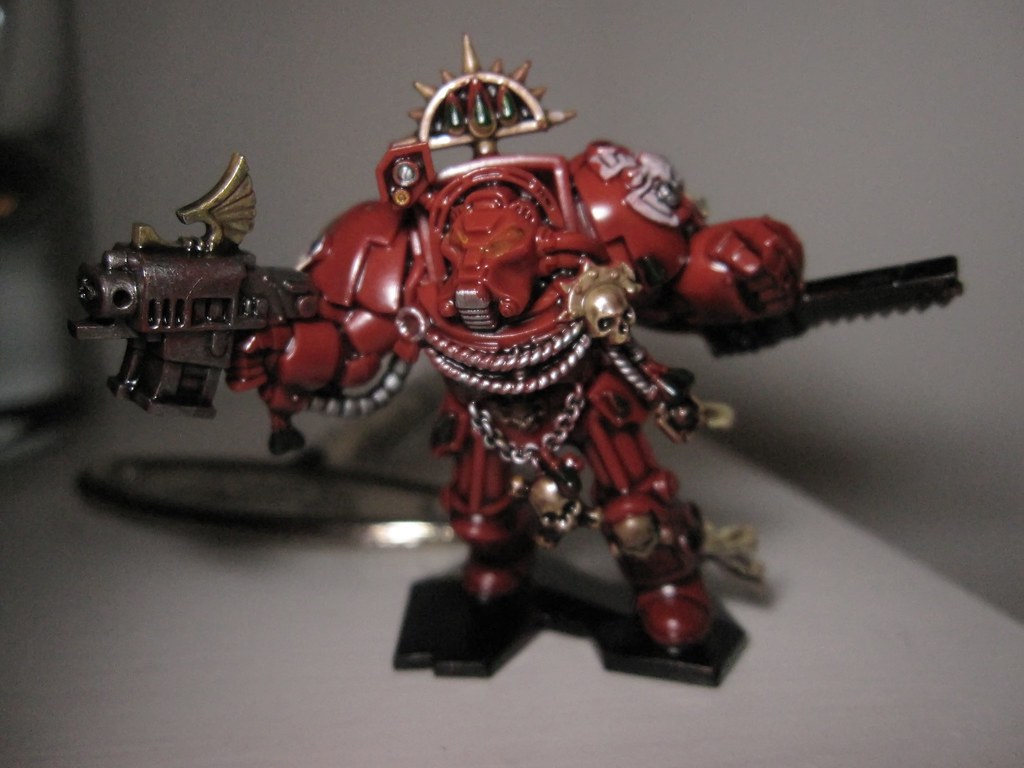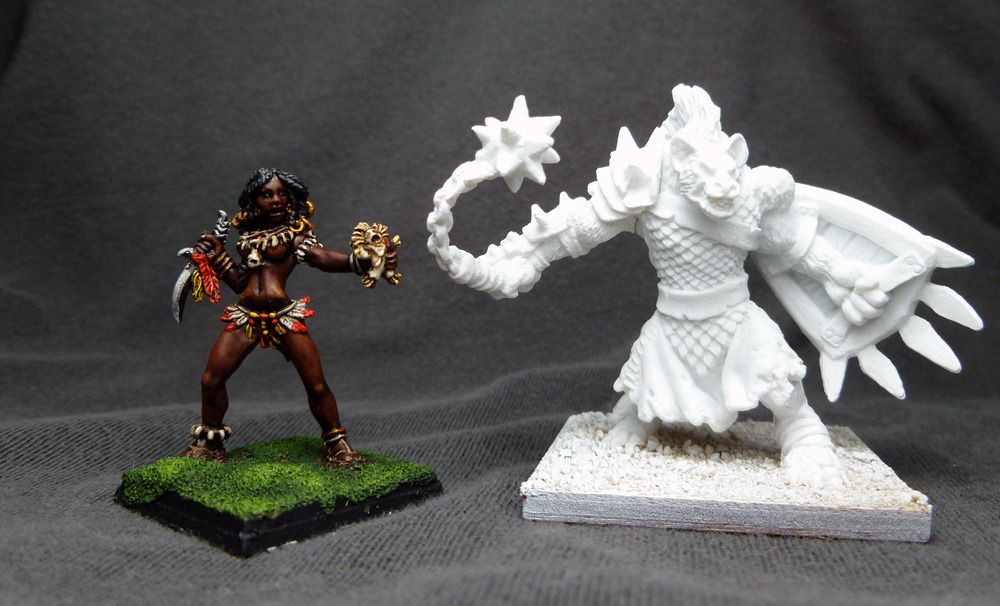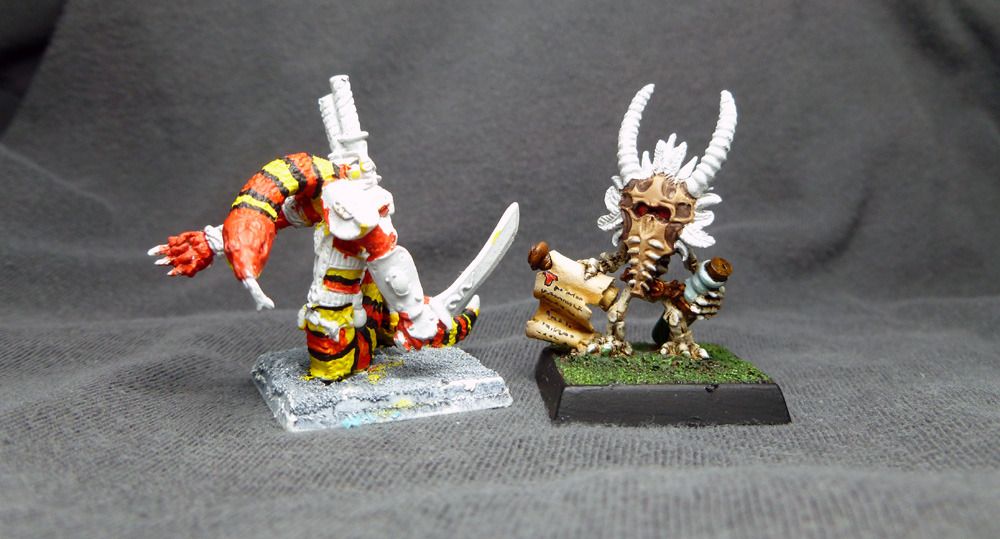Let's get on with our gnoll, then.
I plan to do him step by step as a sort of 'how to'. He's ideal, as much of the recent inspiration around here was brought on by Reaper's Bones Kickstarter, and this gnoll is one of the
already released bones. I didn't think about doing it this way until I had already started preparing the piece, to the first bit here is going to be a little scarce on photos.
Anyway, moving on. The first thing to do when working on a new miniature is to plan, and most of the time (for me, at least) that means research. Here's what we have, straight out of the package:
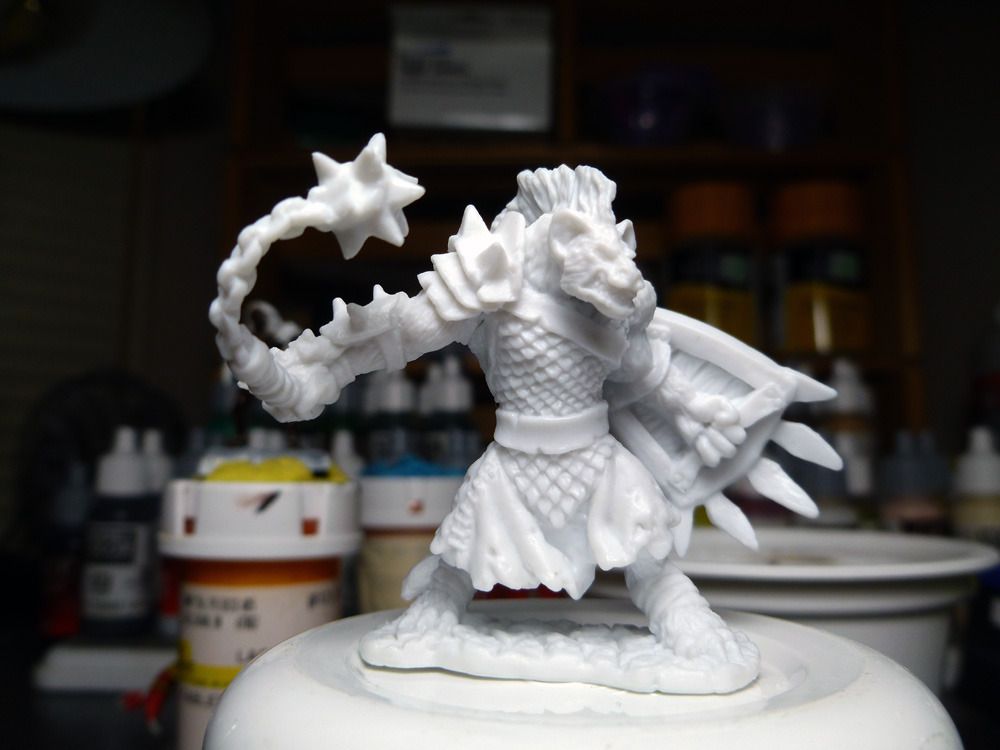
We know it is a gnoll. Not only that, the miniature was originally sculpted for
Warlord, Reaper's miniatures game. He is
Boneflayer, a gnoll sergeant in the Kargir faction. That is relevant to me, as I'm working on a Kargir army. That also means he's a character, and I'll paint him as such, with more detail than I would a regular rank and file miniature. The Warlord: Savage North rulebook says this about him:
Weathered from years of wandering the lowlands, the gnolls produce leaders who excel at raiding and smashing small groups of enemy soldiers. Any gnoll is a fierce opponent, and the ones who lead them are fearless. Crashing into enemy ranks, Boneflayer uses his great mace to deal death to all within reach. Boneflayer will attack any enemy that is near, regardless or rank or value. He is not happy unless he slays more of the enemy than anyone else around him.
That doesn't point out any specific colors or decorations, but it does give us a general feel for the character. He should come across as brutal and bloodthirsty. Gnolls, in most fantasy (including Warlord), are based on the idea of a humanoid hyena. That suits me, and I'll work from that. The next thing I usually do is collect resources. I've got enough fantasy art, RPG books, and screenshots of game moments that caught my attention to give quite a bit of inspiration, and Google Images is invaluable. I'll search for both 'gnoll' and 'hyena'. (You really don't want to know the kind of searches I did to make my zombies look right.)
Gnoll got 187,000 hits, hyena 6.3 million, so I'll narrow it down to those that really fit what I am looking for. Here is what I got (plus a few others):
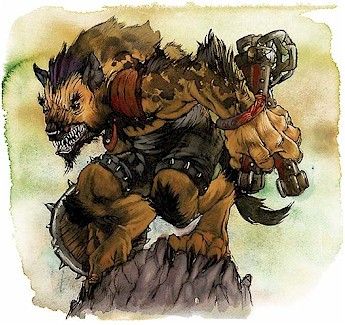

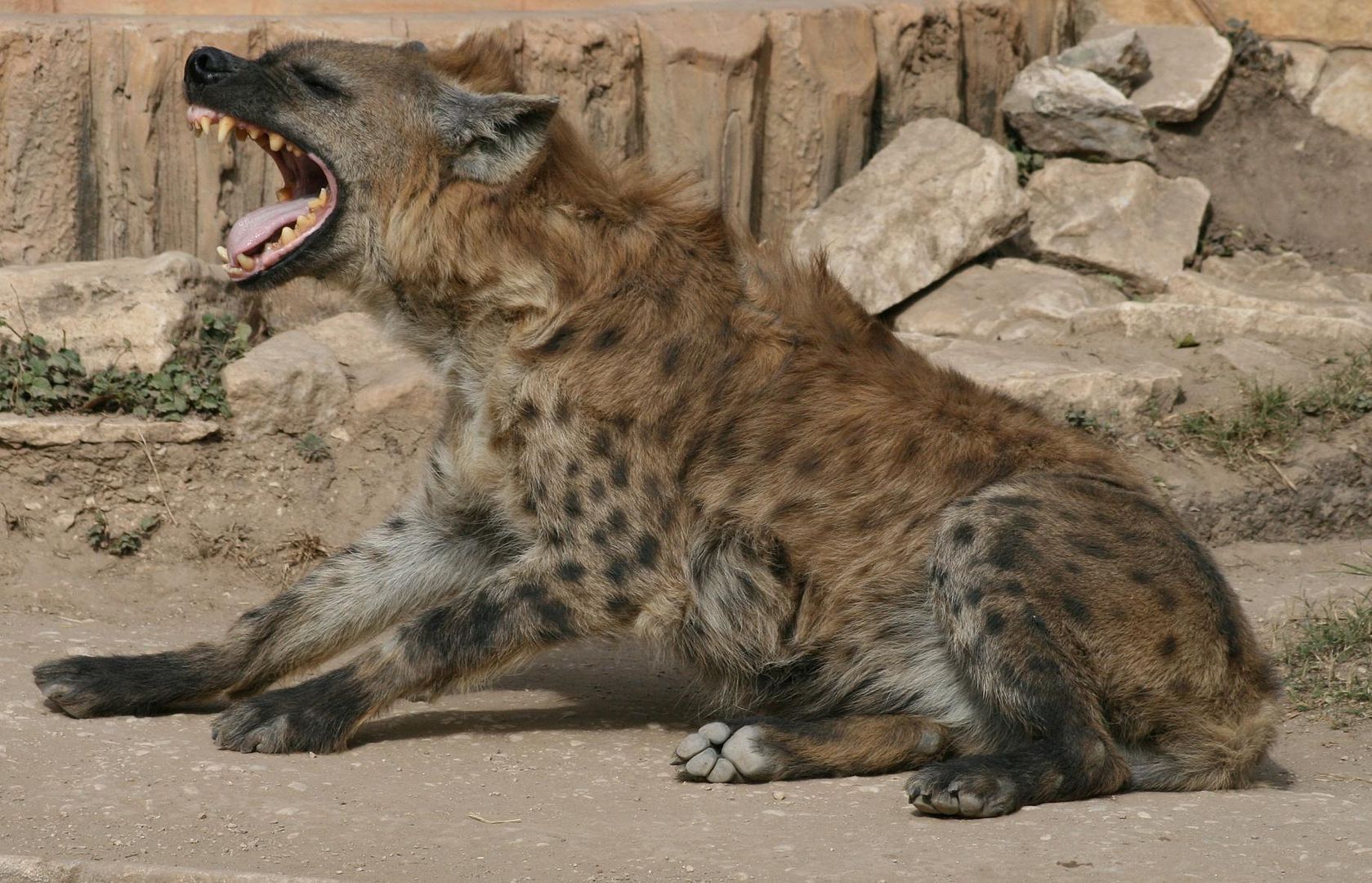
The two hyena shots give me a good idea of what colors I'm looking at. Light cream on the bottom, trendy toward a tannish-yellow, almost orange as it moves up the body, black-brown spots, dark on the face. The gnoll image caught my attention, as I love how the black around his muzzle really brings out the teeth. Now, research like this isn't necessary on every piece. For some pieces I've found a dozen or more images, for others, none. It is just part of how I like to approach it.
Anyway, now I have a plan. I know what the miniature represents, I know what the traditional look is (and this time, I want to go with that), and I have some references for the look. Next up is preparing the miniature to paint.
Stage 1: Cleaning
The first thing to do is the clean up the miniature itself. To get started, you need to remove any flash and mold lines. This is the tiny imperfections that appear around most molded objects, normally a thin line (mold line) where the two halves of the mold meet, but sometimes also areas where the metal or plastic overflowed the mold a little (flash.) Here is an example of a mold line, stolen from the internet. Flash look like an extraneous bit of metal stuck somewhere, like a little growth.
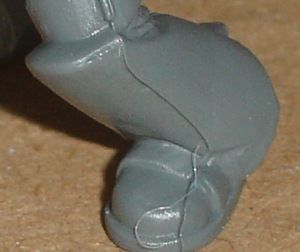
Cleaning the mold line is fairly easy. For metal and plastic miniatures, most of it can be cleaned by simply scraping it with the edge of an X-Acto knife. Thick areas can be cut away or sanded. With Bones, the material is too soft, and scraping and filing don't work well. Instead, very carefully slice the line away, being careful not to cut away the detail in the process. Luckily, Bones seem to have the smallest and least noticeable mold lines I've ever seen in miniatures.
Stage 2: Washing
Miniature molds are usually given a dusting of some sort of release compound to prevent them from sticking inside the mold. Reaper metal minis, for instance, use a dusting of talc. Others use an oil. Furthermore, they're handled by people with hot, sweaty hands while being made, sorted, packaged (and by you when you open them up.) Both release compounds and natural oils can prevent paint from sticking and can result in an uneven paint job.
The next job, then, is to wash the miniature. It isn't hard to get this stuff off. I just get a bowl of very warm water and some Ivory dish soap, let them soak in it for a few minutes, then use a soft bristled toothbrush to gently scrub the whole piece. When you're done, rinse thoroughly with warm or hot water and set them aside to dry for a few hours. That's it.
Tip 1: For the reasons stated above, always wash your hands with soap and hot water before handling your miniatures, including painting them. You don't want to add new oils. This goes quintuple for freshly applied hand lotion, sunscreen, or personal lubricant.

Tip 2: Bones miniatures are PVC plastic, and are softened in high temperatures. Take this into account when you're washing them. As an aside, you can take advantage of this to fix an out of alignment weapon or to tweak a pose. Dip the Bones in hot (not quite boiling) water for twenty or thirty seconds, hold it in the position you want it to hold, then - still holding it in position - dip it in ice water to cool it.
Tip 3: More of a warning, here. Set aside a special bowl for washing miniatures - I use an old plastic coffee container. With Bones and plastic miniatures it likely doesn't matter, but note that most miniatures made prior to the early 90s were made of pure lead. You don't want that in Junior's Fruit Loops. Likewise, don't use a toothbrush you plan to use on your teeth.
Stage 3: Assembly
This step is an important one. Unfortunately, I don't have any multi-part miniatures ready to go right now, so I can't really post a how-to. Instead, I'll link to
this guide, which seems fairly decent. Some quick notes: For assembling plastic or Bones, stick with super glue. For metal, super glue doesn't bond well - use a two-part epoxy. For heavy pieces, consider drilling and pinning.
Stage 4: Basing.
Note the original photo of the gnoll up there - just like all the other Bones, he has a built in 'broccoli' base, a lump of shaped plastic. Bases like this are fairly common. If you just plan on roleplaying with them and aren't dealing with rules that specify base size or shape, then you're fine leaving them like they are. Here is a piece I painted years and years ago that has a painted broccoli base:
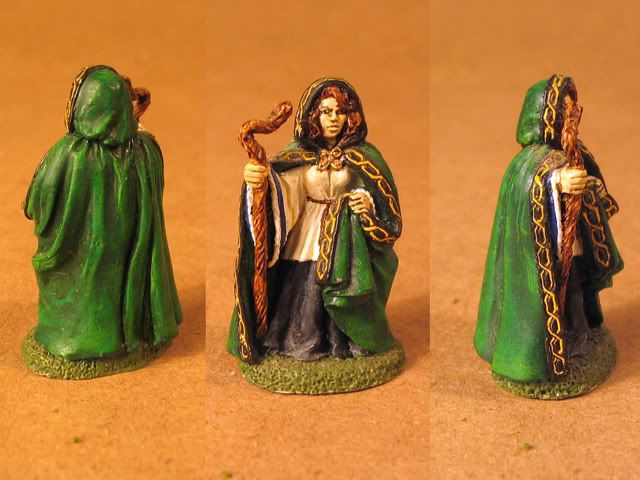
Many miniatures come with a slotted or 'slotta' (old GW term) base. These bases have a long slot in them, and the miniature has a narrow strip under the feet that fits in the base. A drop of super glue is fine for any material on these, although you should do a dry test to make sure they fit in before applying the glue. If there are gaps, they can be closed off with a little bit of Milliput/green stuff, or if they're small, later on with glue and sand. The woman with the crossbow I posted earlier has a slotted base. Another example of a slotted base:
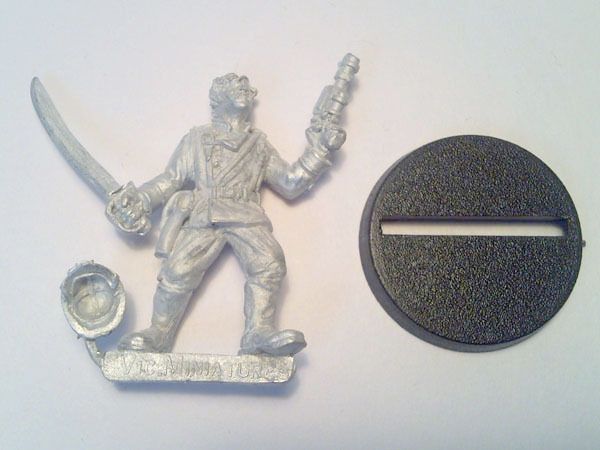
Since I plan to use Boneflayer here for playing Warlord, I have to follow Warlord's rules, which specify base size and shape. You can also re-base miniatures just to give yourself a working surface to make a more elaborate base. Boneflayer uses a 'large' base, which means a 1 1/2" square. I looked at options for basing Bones, and the cheapest place I found was Litko, which offers
ultra-fine plywood bases for a small fraction of the cost the plastic bases cost elsewhere. 1" Plastic bases: ~$8 for 20. 1" Litko bases: $11.99 for 100. They do every imaginable size, although they're slow, as they cut them to order. I've never used wooden bases before, so this will be a new experience for me, too, but I have some 1.5" pieces here to test, and I'm very happy with what I've seen so far. Anyway, on to basing Boneflayer.
First, remove him from his broccoli base. I did this very carefully with an X-Acto knife. I started at the claws to ensure the I cut under them, then simply pushed the knife straight back. It sliced very, very easily.
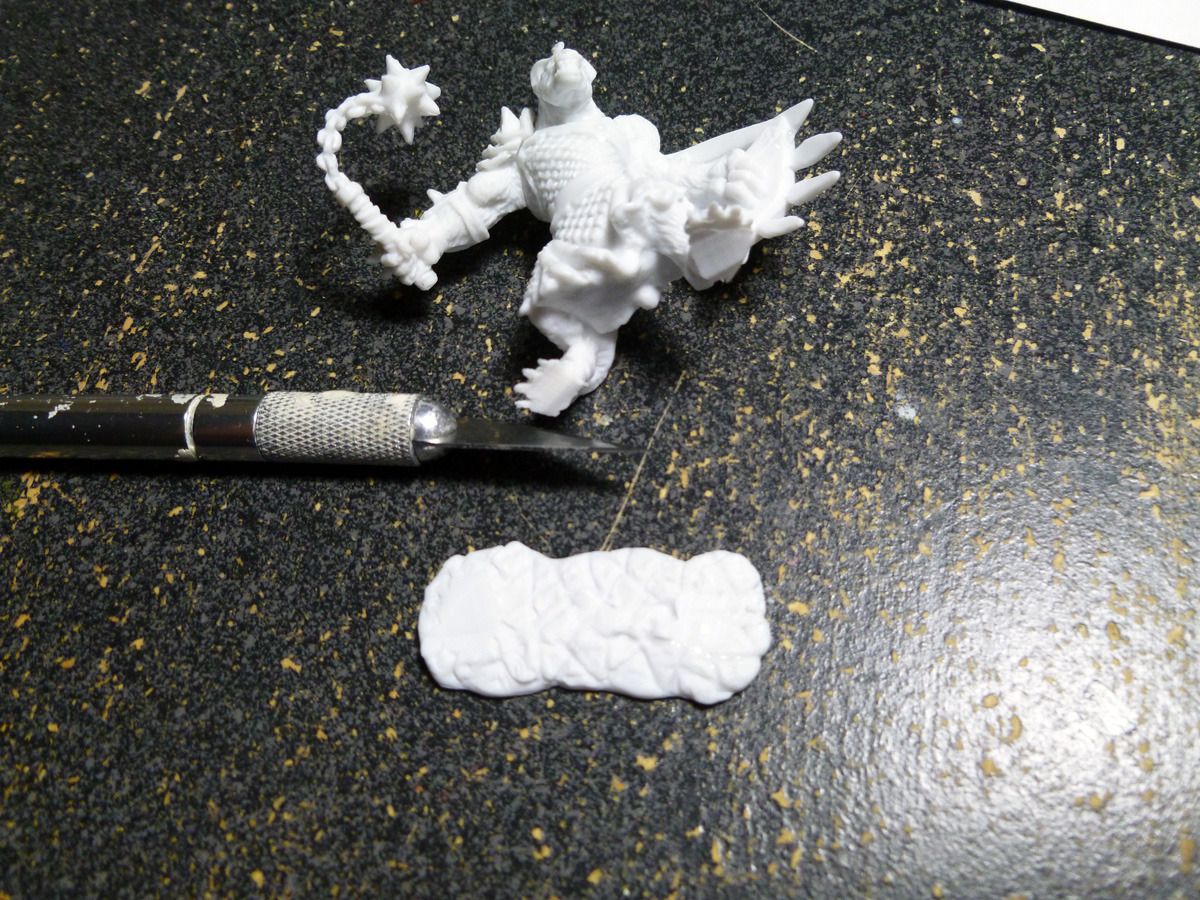
Second, I drilled each foot. You could probably glue them directly to the base (especially the wood bases), but since I already have the tools sitting here, I decided it couldn't hurt to give them the extra support. Line up the drill carefully so that you are drilling into solid plastic and not just through the top of the foot. The hand drill worked extremely well on the Bones plastic - don't use a dremel for these things. You'll drill the poor gnoll in half before you realize it.
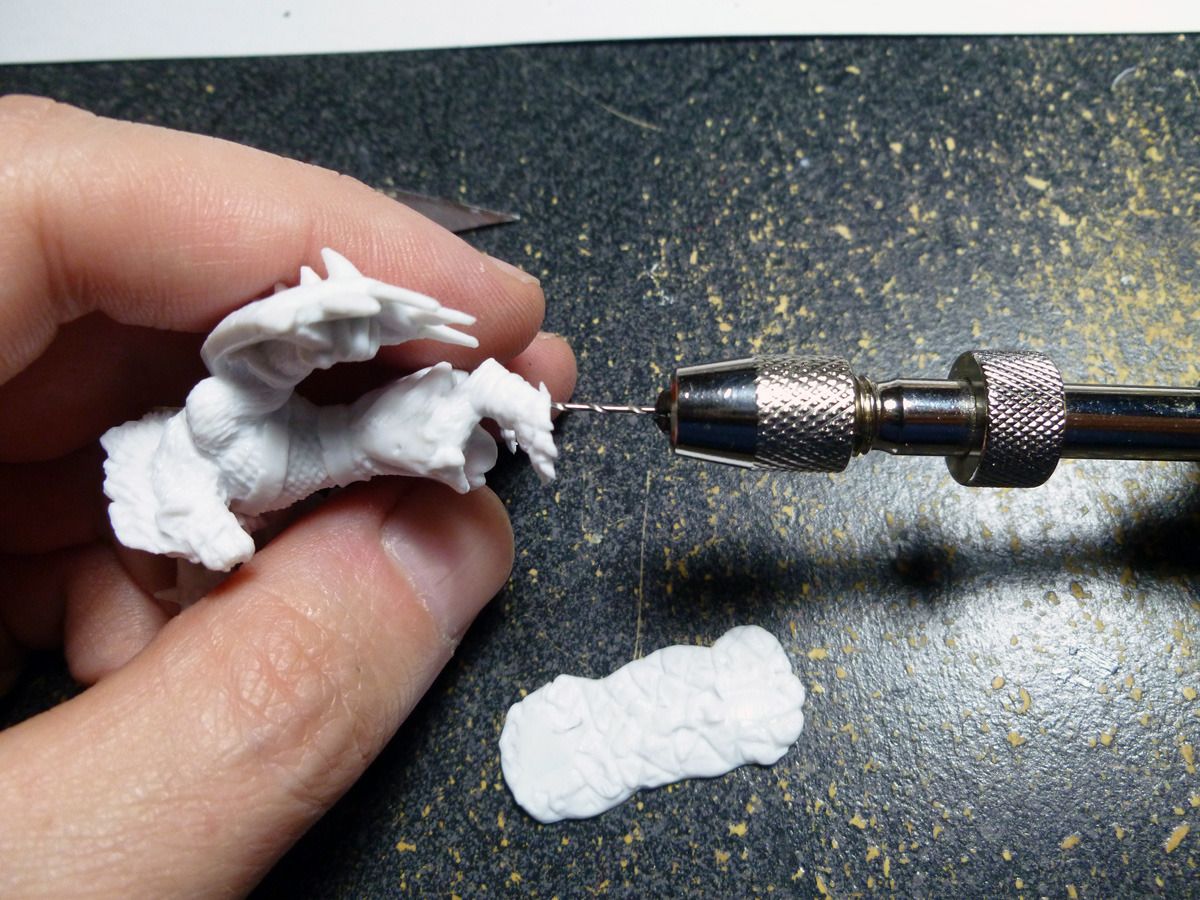
Next, insert a rod into each hole with a tiny drop of super glue:

Cut the rods to length. The bases are 3mm thick, so cut the rods a little shorter than that.
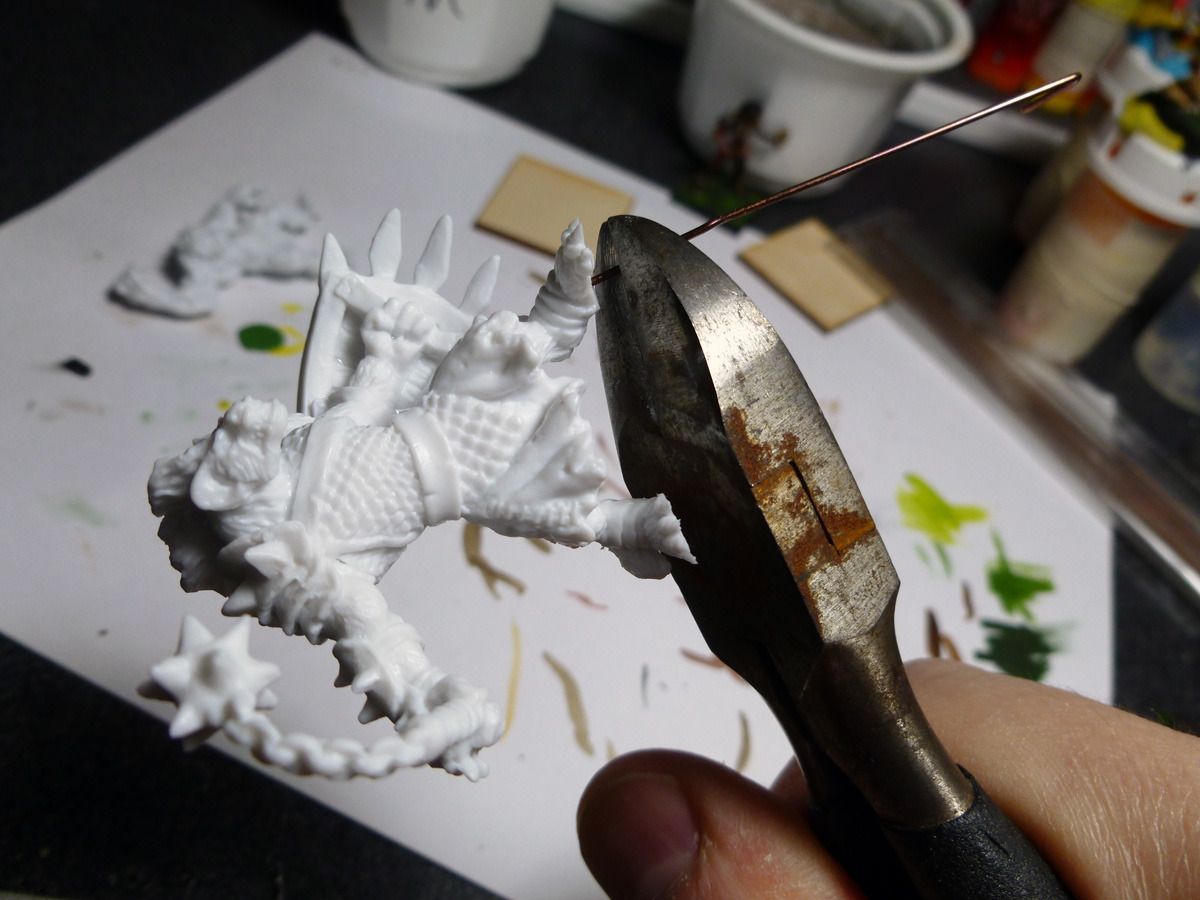
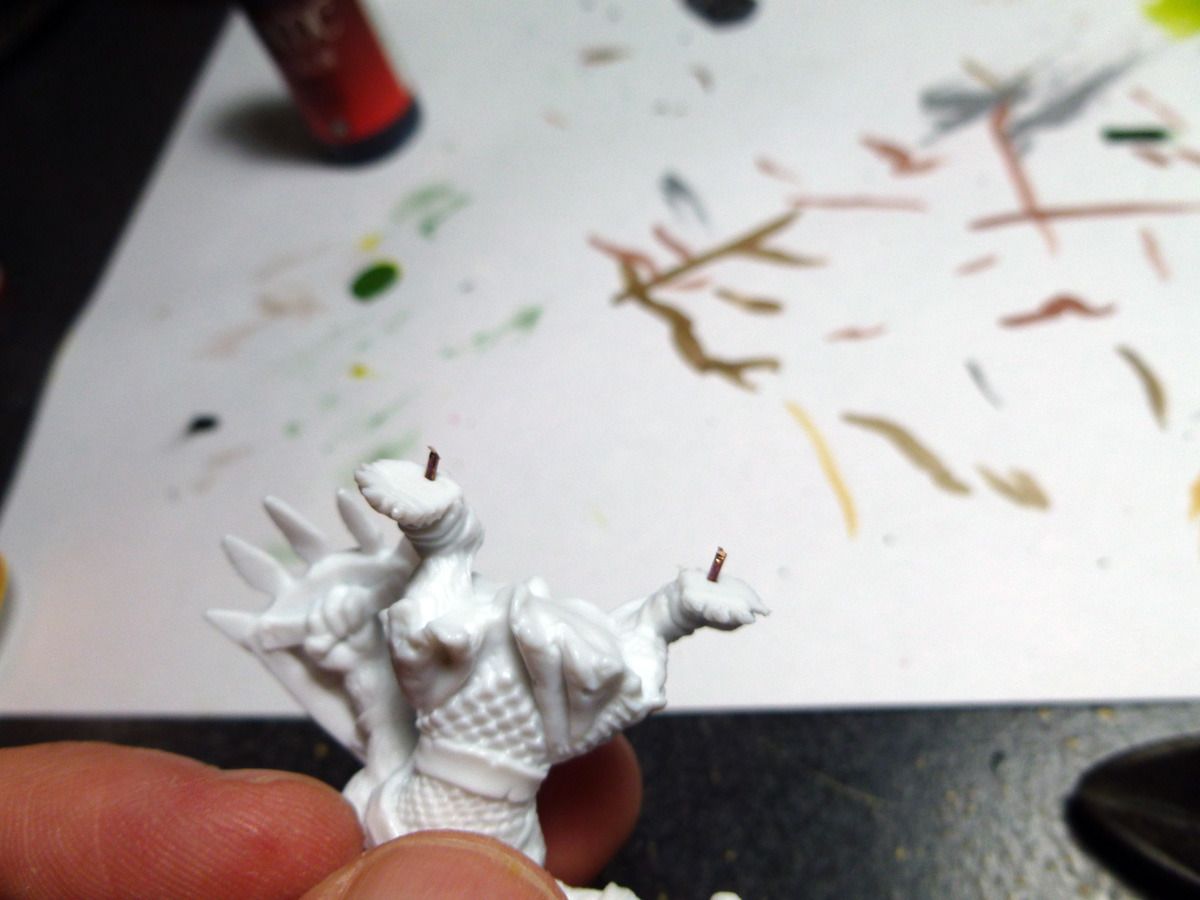
Next, figure out exactly how you want him to stand on the base. Facing 90 degrees toward the front rarely looks good, but you don't want it to be ambiguous as to which side
is the front. Touch each pin lightly to some paint, and set him on the base to mark it.
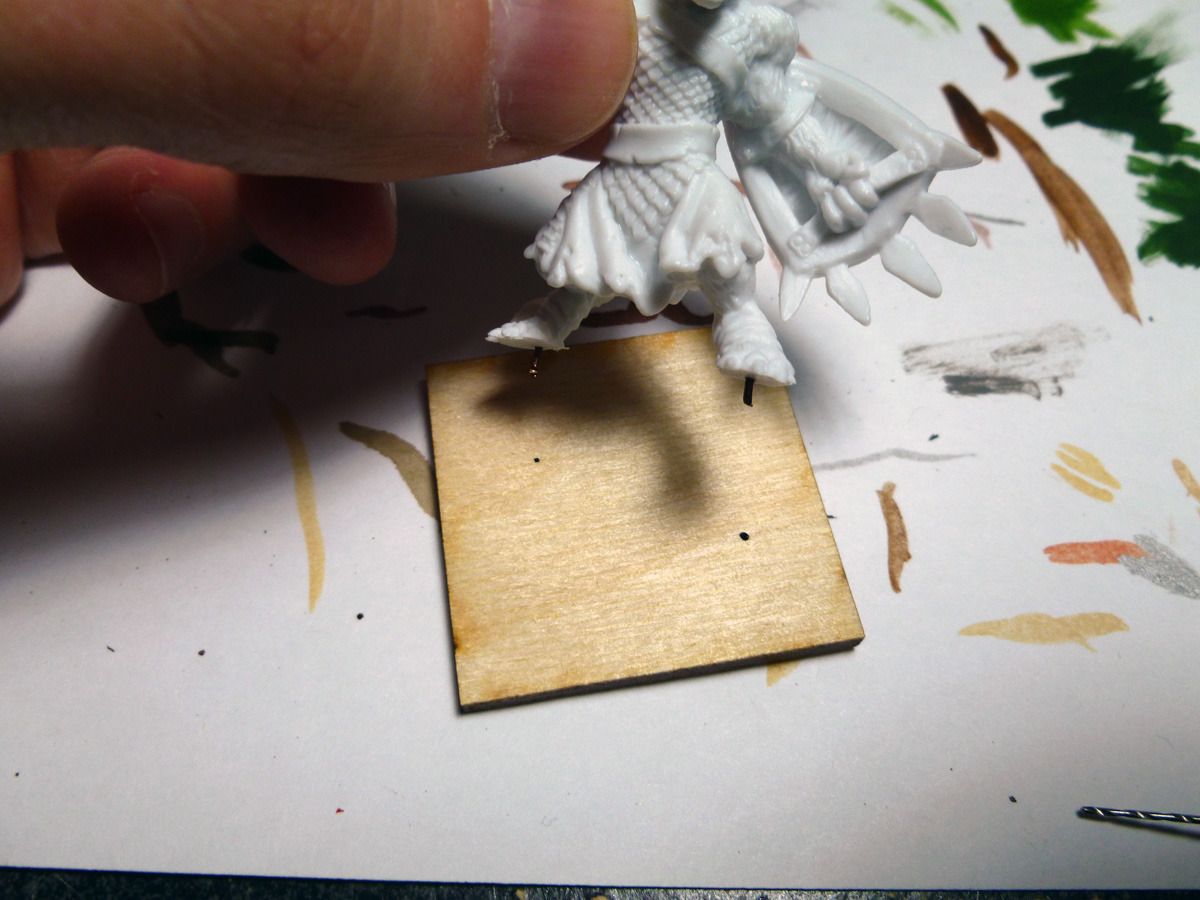
Drill holes where the paint marks were.
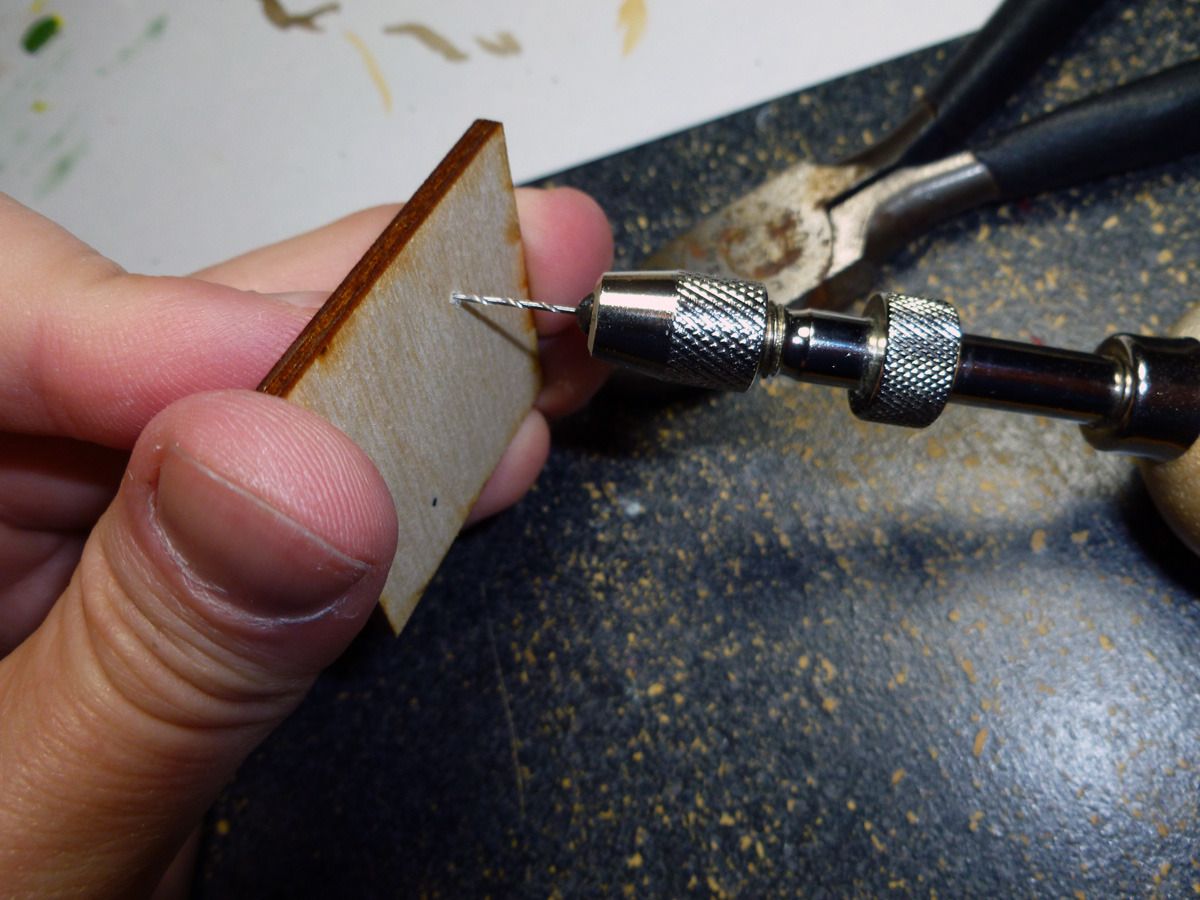
Next, apply a tiny drop of superglue on tips of the rods, plus a little on the soles of his feet to hold him in place. Stick rod A in hole B. Press firmly.
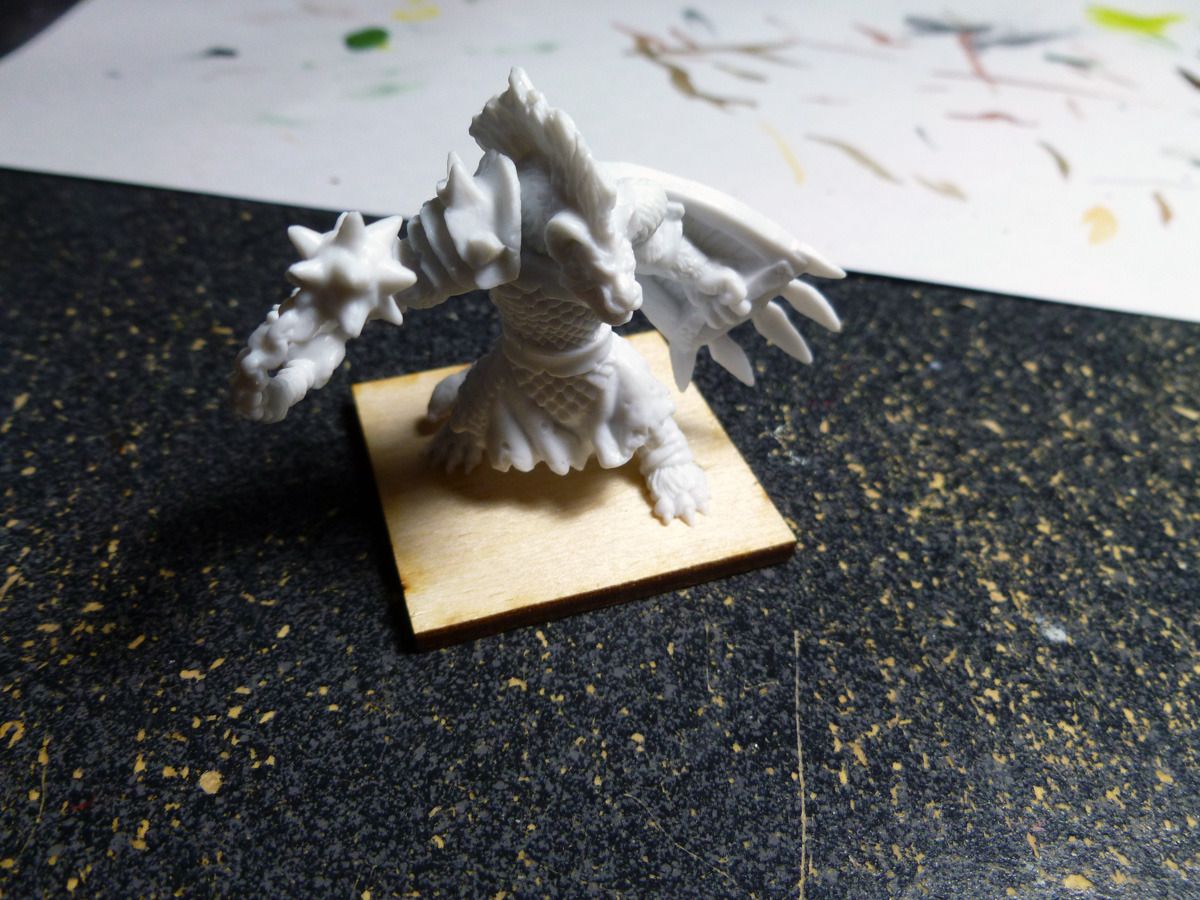
Let him sit for a bit to dry, then began to prep the base itself. Add a little white glue, and spread it with a toothpick. Be careful to keep it off of the miniature itself, but cover all of the areas of the base.
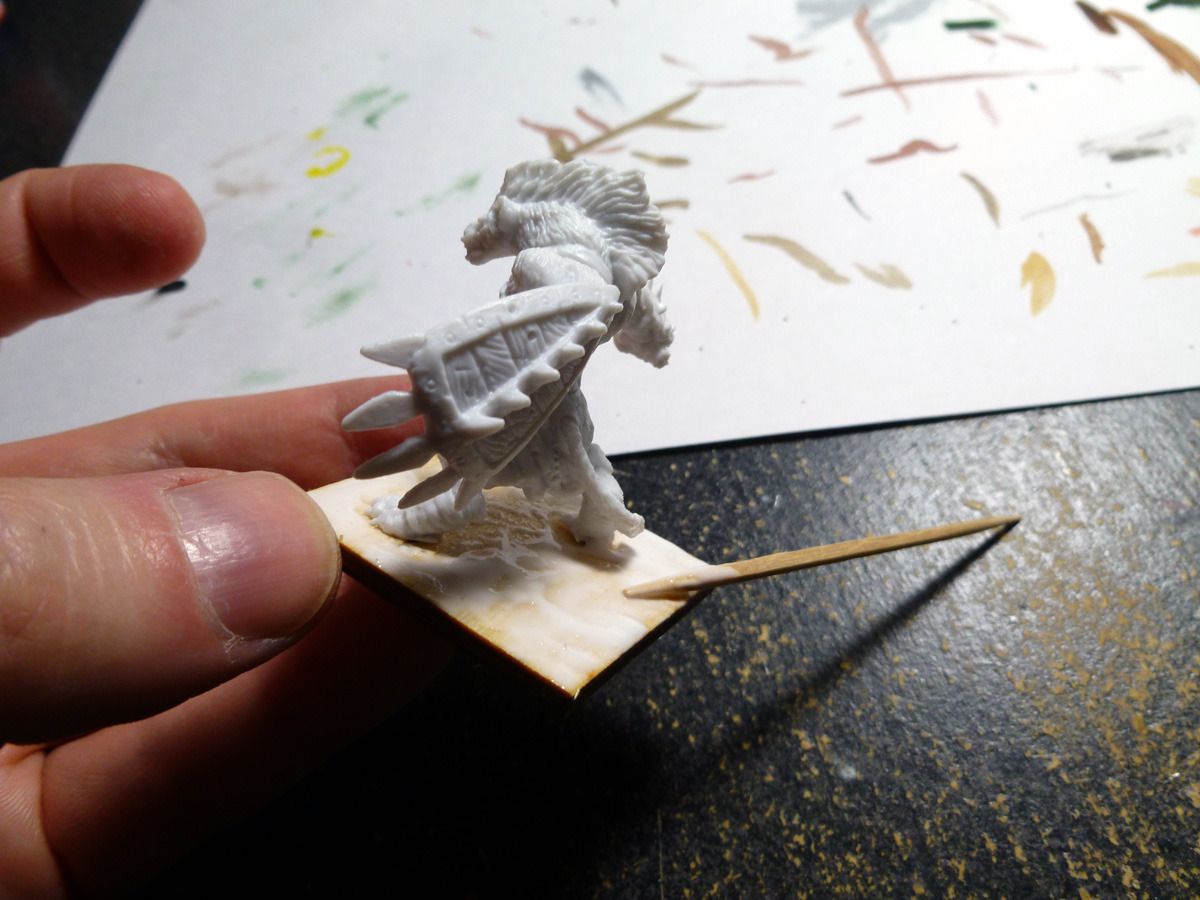
Now, dip the whole base into sand. Leave him there for a minute or so (but not much longer than that.) Set him aside, but don't shake off any excess yet. Carefully check around his feet and legs to make sure you didn't get any glue/sand on there. If so, use a toothpick or similar to remove it before the glue dries.
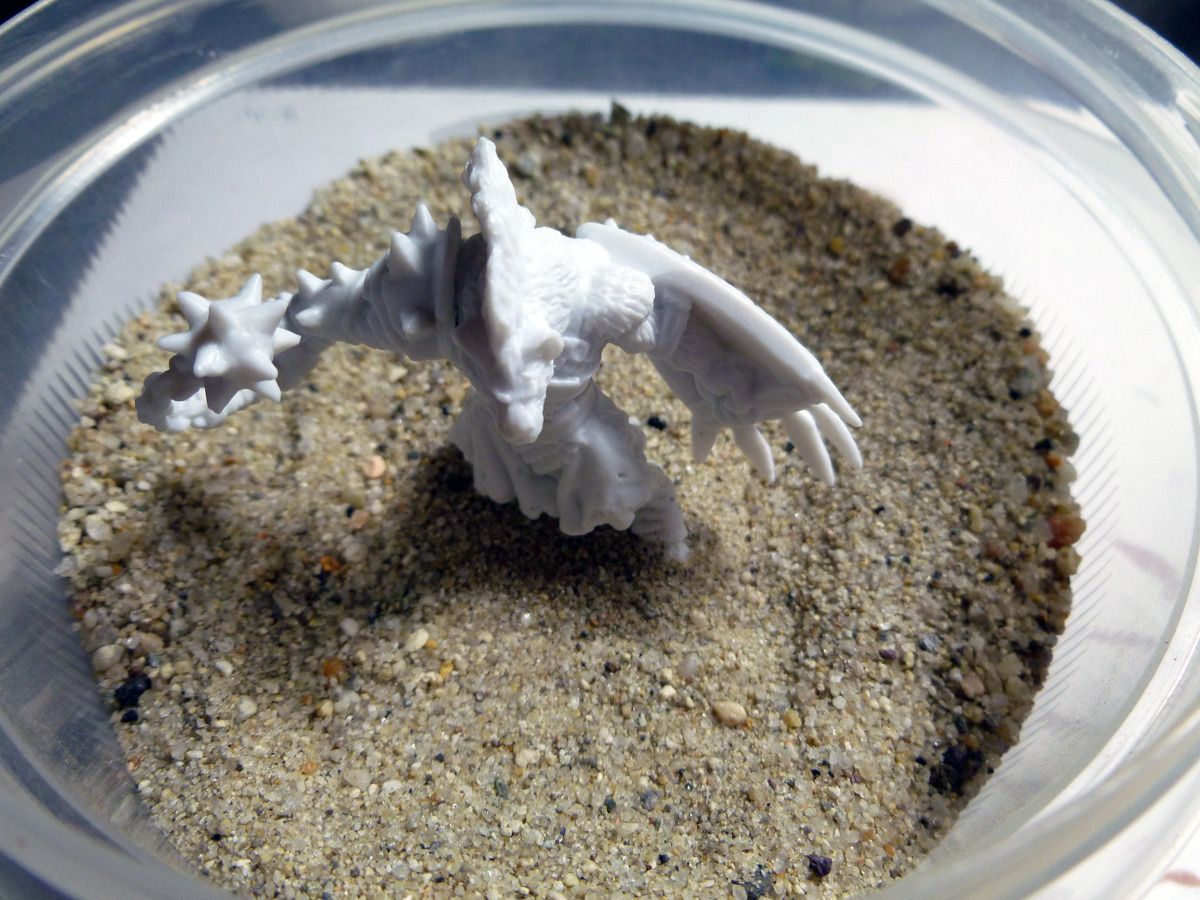
After a few hours, blow off the excess sand. I sometimes use a soft brush over the whole thing to make sure that all the loose sand is removed. The result is a nice, neat sand base, ready for priming.
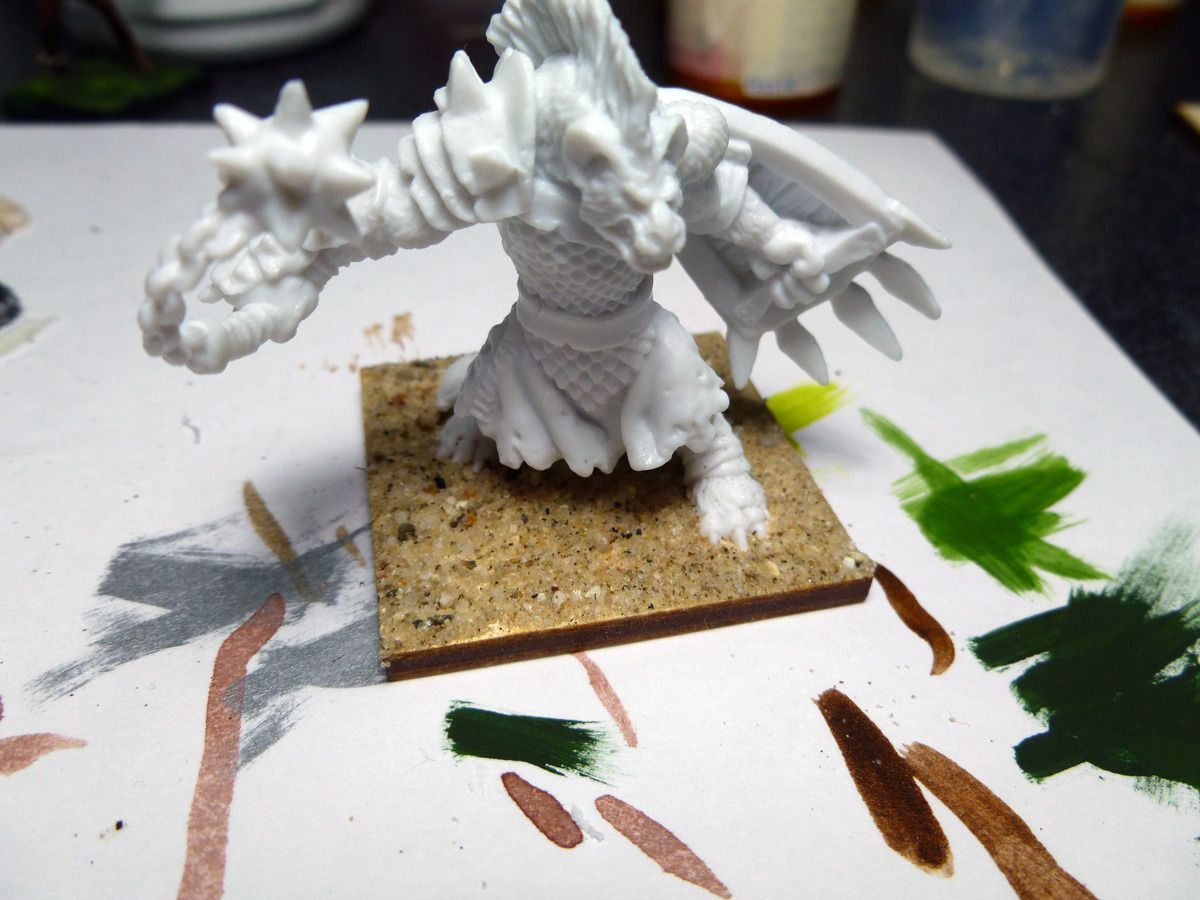
I'll get into basing later on when the time comes, but I'd like to show some of the basic options here.
One option, if you choose, is to take a little milliput and add some bumps and shaping to the base before sanding it. Here is what I'm talking about on a Bones troll's base:

I'll give an example here to show what a base would look like, finished, with nothing but the sand. This is an 'in progress' piece I'm working on right now, and will be adding detail to her base later, but at this point it is painted as a simple sand base. The nice thing about this approach is that it is extremely durable. The sand is glued on the base, has a layer of primer over to help hold it down, several layers of paint, and will have a coat of varnish when the piece is done. It is quick, easy, cheap, and very durable, even if you don't go further. The woman with the crossbow, posted earlier, started off this same way.
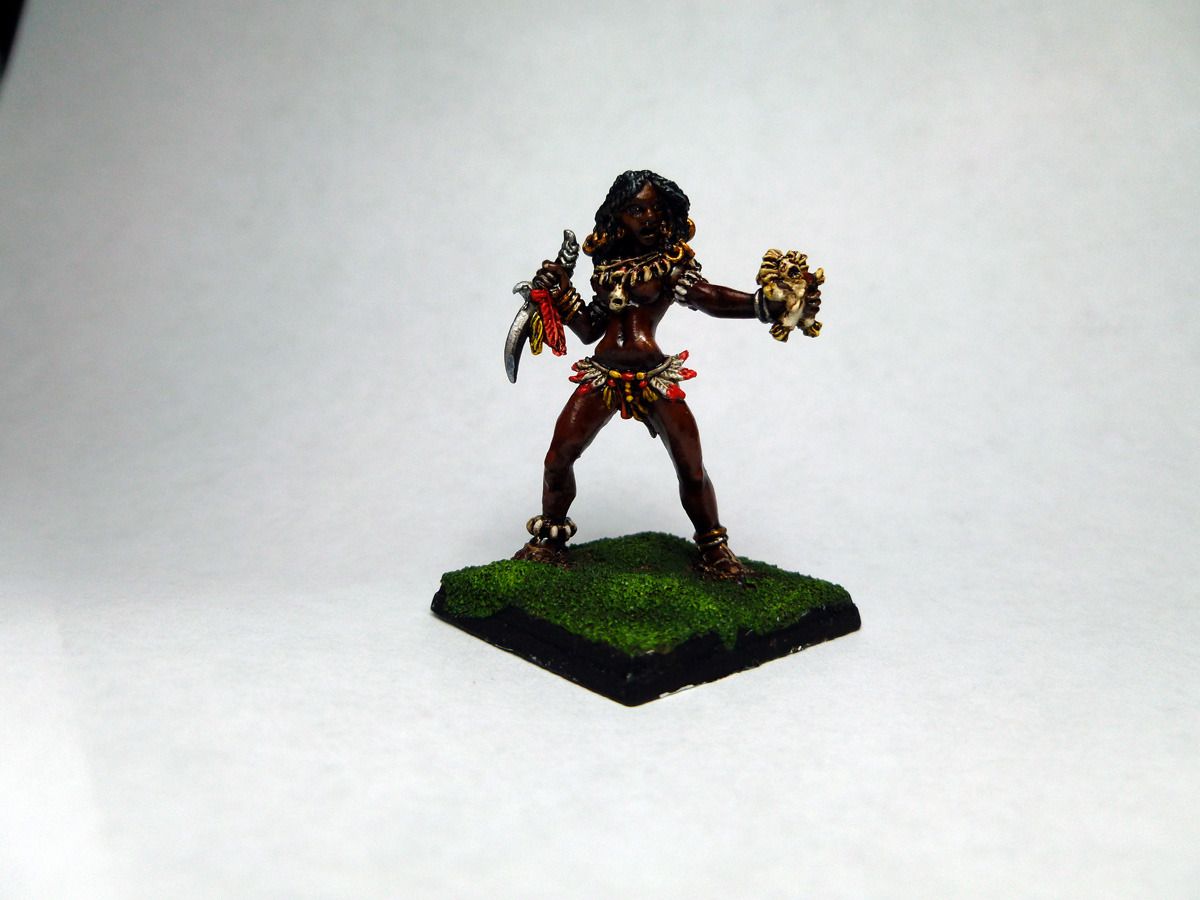
Another choice is to leave the broccoli base on and use milliput to build the rest of the base up to it, either leveling it with the top or making it look like the the figure is standing on a short hill.
Another alternative is to cover the whole base with milliput, then carve it. This fellow's flag stones were done this way, as was the halfling bard's I posted earlier. It is easier than it sounds. I have zero talent when it comes to sculpting, and still didn't have any trouble getting acceptable results:

Priming
Ok, moving on to priming. I can't discuss brush-on primers, as I don't use them. I use spray primers. The purpose behind priming is to give the paint a surface to stick to. Bones can be painted without priming, so long as you don't thin the base coats, but not thinning the base coats isn't my preferred way to work, so I'll prime anyway. Metal and plastic miniatures need primed regardless.
After my tests previously showed my usual Krylon primer (an enamel primer) didn't work on Bones, I did some research and decided to try
Army Painter brand spray primer. It works beautifully on Bones, and I'm happy enough with the results that I'll be tossing my Krylon and using this stuff for all miniatures from now on. It is a fast drying spray acrylic designed specifically for miniatures.
We had some discussion before on primer colors. I prime white - it is just my preference, but some people prefer black or gray. I've used all three. In general, white primer leads to brighter miniatures with smoother blends. You have to paint the shadows in yourself, which results (in my opinion) with more natural shadows, as they tend to be colored. Black primer creates a more intense contrast, and the shadows tend to be much darker, while you have to paint more highlights. The pieces aren't as bright when you're done.
Now, certain pieces still work better with one or the other. I wouldn't want to paint an army of High Elves, in white robes and silver armor over black primer, but for an army of evil, chaotic warriors, it might be perfect. When I was playing Warhammer, I primed my Night Goblins with black, just because every one of them wore black.
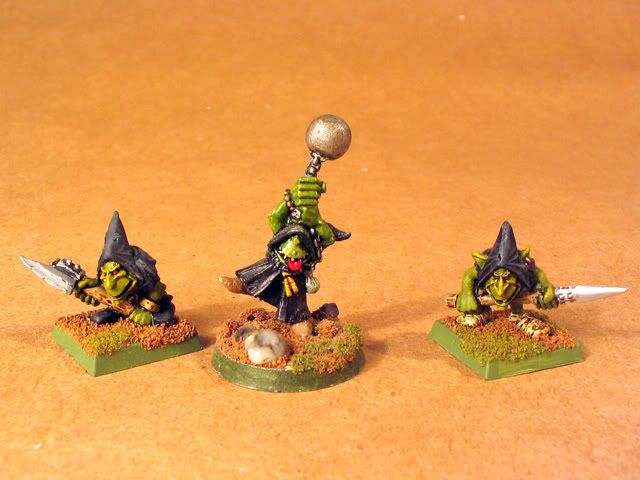
If you were painting a large group of miniatures that were all predominantly the same color (say, blue lizardmen), then a colored primer might also be viable, although I've never used it myself. Another recent trend has been priming with gesso, but I have zero experience with this medium, so I can't really comment on it.
So, on to the priming. As mentioned earlier, there are several ways to hold a figure for spray priming. For an army, I like to get an old cereal box or something and hot glue them down, a few inches apart. For individual, like our gnoll, I prefer to use my spindles. Remember not to use much hot glue. You want to hold them in place for a few minutes, not give yourself headaches trying to remove them. Here's Boneflayer, ready to go:
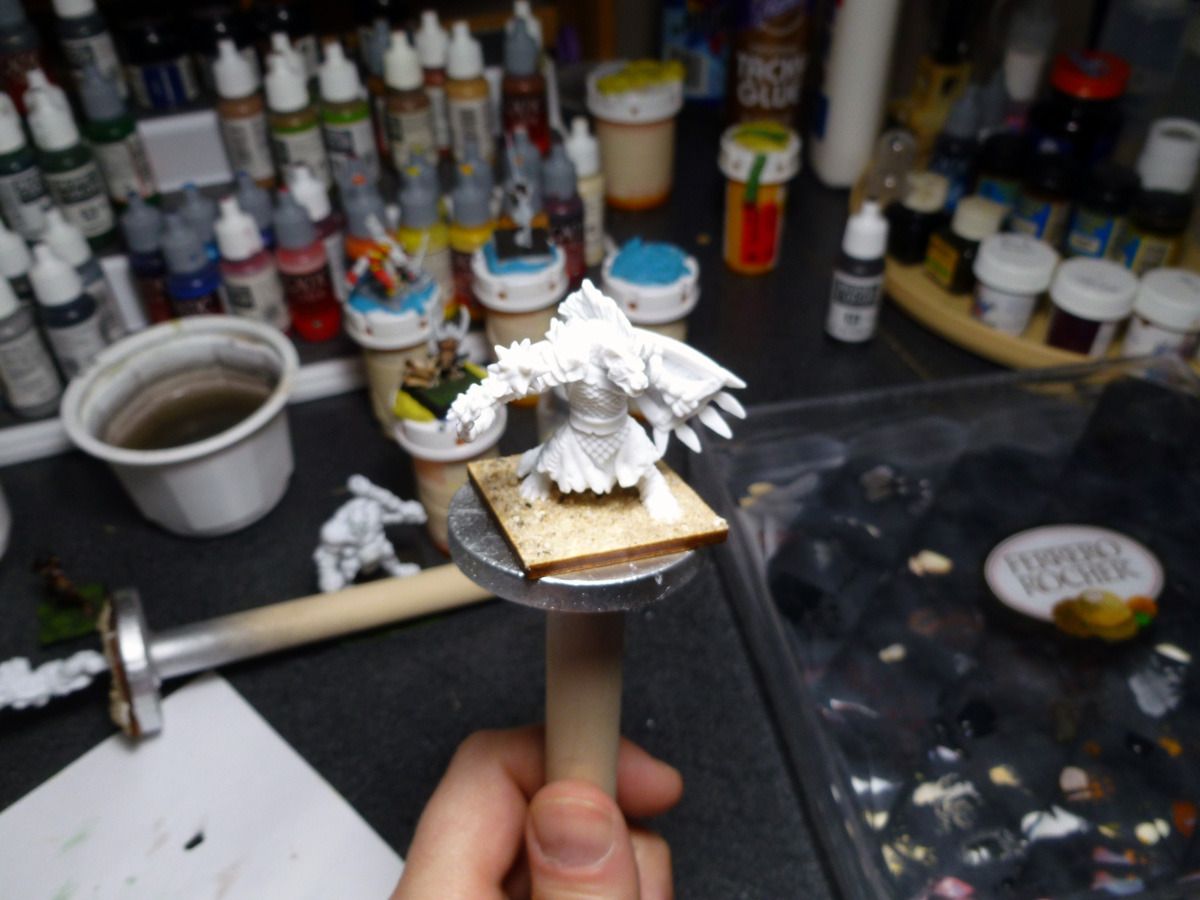
Now, when you prime a miniature, the goal is
not to cover the miniature with an even layer of paint. Doing so achieves two things: 1) you trade the too-smooth natural surface for another too-smooth surface, and 2) you end up filling in details with paint. Remember the guy who painted a baseball with many layers of paint?
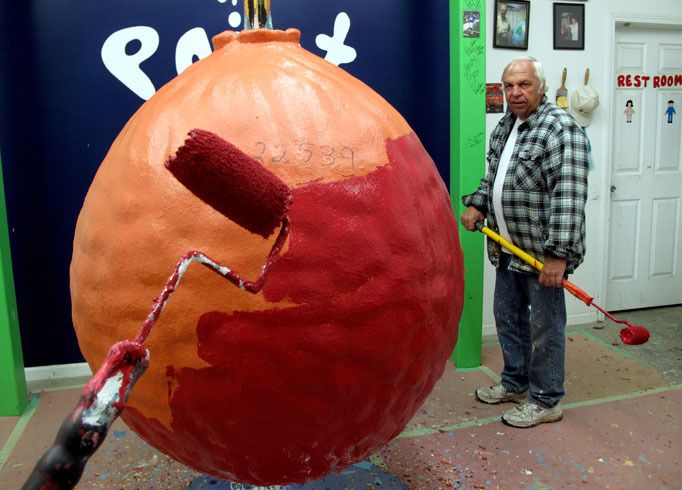
You don't want too much paint on your miniature for the same reason. You don't want it to be pure white (or black, or...) Areas where you can still see the metal are
perfectly fine, and the surface should be a tiny bit uneven. Not speckled, but not smooth white, either. That's the point - you want to create a surface the paint can stick to. A lot of people over-prime their miniatures.
Paint at the right distance (six inches to one foot on most cans, experiment with yours on a piece of wood.) Paint in short bursts rather than holding down the button the whole time. One good tip is not to prime the same spot twice. It's good enough.
Here's Boneflayer, primed.
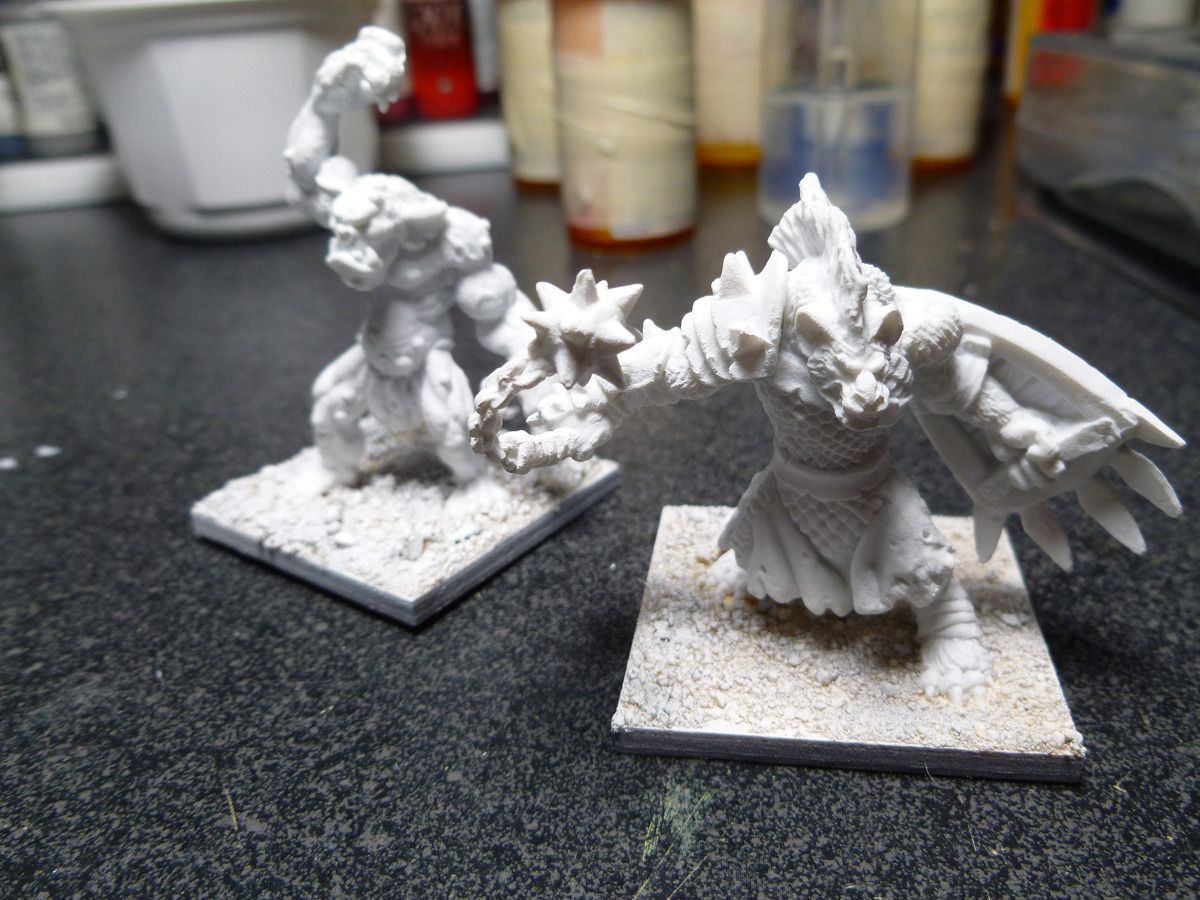
Unfortunately, he is primed white over white plastic, so you really can't see much. Here is an image I found of a bust primed just the way I'm talking about:

You'll notice that he didn't make the thing pure, shining white. You can see lots of the underlying material, particularly in the hair and beard. Note: The site I found that example on has a fantastic primer on priming (hork.) It goes into far more detail than I am.
check it out.
Alrighty, then. This is caught up to where I'm at on this piece. I suppose I should put brush to paint next.
What doesn't kill me makes me stranger.
